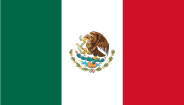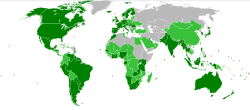Mexico
| United Mexican States | ||||||
|---|---|---|---|---|---|---|
|
||||||
| Anthem: "Himno Nacional Mexicano" Mexican National Anthem |
||||||
| National seal: Seal of the United Mexican States |
||||||
.svg.png) |
||||||
| Capital (and largest city) |
Mexico City |
|||||
| Official language(s) | Spanish [1] | |||||
| Recognised regional languages | 62 Indigenous Amerindian languages[3] | |||||
| Demonym | Mexican | |||||
| Government | Federal Republic[4] | |||||
| - | President | Felipe Calderón (PAN) | ||||
| - | Secretary of the Interior | José Francisco Blake Mora | ||||
| - | Supreme Court President | Guillermo Ortiz Mayagoitia | ||||
| Legislature | Congress | |||||
| - | Upper House | Senate | ||||
| - | Lower House | Chamber of Deputies | ||||
| Independence | from Spain | |||||
| - | Declared | September 16, 1810 | ||||
| - | Recognized | September 27, 1821 | ||||
| Area | ||||||
| - | Total | 1,972,550 km2 (15th) 761,606 sq mi |
||||
| - | Water (%) | 2.5 | ||||
| Population | ||||||
| - | July 2009 estimate | 111,211,789[5] (11th) | ||||
| - | 2005 census | 103,263,388 | ||||
| - | Density | 55/km2 (142nd) 142/sq mi |
||||
| GDP (PPP) | 2010 estimate | |||||
| - | Total | $1.541 trillion[6] (11) | ||||
| - | Per capita | $14,495[6] (45th) | ||||
| GDP (nominal) | 2010 estimate | |||||
| - | Total | $1.085 trillion[6] (13) | ||||
| - | Per capita | $10,211[6] (46th) | ||||
| Gini (2008) | ▼ 46.1[7] (high) | |||||
| HDI (2007) | ||||||
| Currency | Peso (MXN) |
|||||
| Time zone | Official Mexican Timezones (UTC-8 to −6) | |||||
| - | Summer (DST) | varies (UTC-7 to −5) | ||||
| Drives on the | right | |||||
| Internet TLD | .mx | |||||
| Calling code | +52 | |||||
Mexico, (pronounced /En-us-Mexico.oggˈmɛksɪkoʊ/; Spanish: México [ˈmexiko] (![]() listen)), officially known as the United Mexican States[9] (Spanish: Estados Unidos Mexicanos), is a federal constitutional republic in North America. It is bordered on the north by the United States; on the south and west by the Pacific Ocean; on the southeast by Guatemala, Belize, and the Caribbean Sea; and on the east by the Gulf of Mexico.[10][11] Covering almost 2 million square kilometres (over 760,000 sq mi),[12] Mexico is the fifth-largest country in the Americas by total area and the 14th largest independent nation in the world. With an estimated population of 111 million,[13] it is the 11th most populous country and the most populous Hispanophone country on Earth. Mexico is a federation comprising thirty-one states and a Federal District, the capital city.
listen)), officially known as the United Mexican States[9] (Spanish: Estados Unidos Mexicanos), is a federal constitutional republic in North America. It is bordered on the north by the United States; on the south and west by the Pacific Ocean; on the southeast by Guatemala, Belize, and the Caribbean Sea; and on the east by the Gulf of Mexico.[10][11] Covering almost 2 million square kilometres (over 760,000 sq mi),[12] Mexico is the fifth-largest country in the Americas by total area and the 14th largest independent nation in the world. With an estimated population of 111 million,[13] it is the 11th most populous country and the most populous Hispanophone country on Earth. Mexico is a federation comprising thirty-one states and a Federal District, the capital city.
In Pre-Columbian Mesoamerica many cultures matured into advanced civilizations such as the Olmec, the Toltec, the Teotihuacan, the Zapotec, the Maya and the Aztec before the first contact with Europeans. In 1521, Spain conquered and colonized the territory, which was administered as the viceroyalty of New Spain which would eventually become Mexico as the colony gained independence in 1821. The post-independence period was characterized by economic instability, territorial secession and civil war, including foreign intervention, two empires and two long domestic dictatorships. The latter led to the Mexican Revolution in 1910, which culminated with the promulgation of the 1917 Constitution and the emergence of the country's current political system. Elections held in July 2000 marked the first time that an opposition party won the presidency from the Institutional Revolutionary Party (Spanish: Partido Revolucionario Institucional, PRI).
As a regional power,[14][15] and since 1994 the first Latin American member of the Organisation for Economic Co-operation and Development (OECD), Mexico is firmly established as an upper middle-income country,[16] and is considered a newly industrialized country[17][18][19][20] and an emerging power.[21] It has the 13th largest nominal GDP and the 11th largest by purchasing power parity. The economy is strongly linked to those of its North American Free Trade Agreement (NAFTA) partners, especially the United States,[22][23] as well as tourism, being the world's tenth most visited country with over 21.4 million international arrivals.[24] Mexico boasts a long tradition in the arts, renowned cuisine, and culture, and it ranks fifth in the world and first in the Americas on the list of UNESCO World Heritage Sites with 31.[25][26][27]
Etymology

After New Spain won independence from Spain, it was decided that the new country would be named after its capital, Mexico City, which was founded in 1524 on top of the ancient Aztec capital of México-Tenochtitlan. The name comes from the Nahuatl language, but its meaning is not known. It has been suggested that it is derived from Mextli or Mēxihtli, a secret name for the god of war and patron of the Aztecs, Huitzilopochtli, in which case Mēxihco means "Place where Mēxihtli lives".[28]
Another hypothesis suggests that the word Mēxihco derives from the mētztli ("moon"), xictli ("navel", "center" or "son"), and the suffix -co (place), in which case it means "Place at the center of the moon" or "Place at the center of the Lake Moon", in reference to Lake Texcoco.[29] The system of interconnected lakes, of which Texcoco was at the center, had the form of a rabbit, the same image that the Aztecs saw in the moon. Tenochtitlan was located at the center (or navel) of the lake (or rabbit/moon).[29] Still another hypothesis suggests that it is derived from Mēctli, the goddess of maguey.
The name of the city was transliterated to Spanish as México with the phonetic value of the x in Medieval Spanish, which represented the voiceless postalveolar fricative /ʃ/. This sound, as well as the voiced postalveolar fricative /ʒ/, represented by a j, evolved into a voiceless velar fricative /x/ during the sixteenth century.[30] This led to the use of the variant Méjico in many publications in Spanish, most notably in Spain, whereas in Mexico and most other Spanish–speaking countries México was the preferred spelling. In recent years the Real Academia Española, which regulates the Spanish language, determined that both variants are acceptable in Spanish but that the normative recommended spelling is México.[31] The majority of publications in all Spanish-speaking countries now adhere to the new norm, even though the alternative variant is still occasionally used.[32] In English, the x in Mexico represents neither the original nor the current sound, but the consonant cluster /ks/.
The official name of the country has changed as the form of government has changed. On two occasions (1821–1823 and 1863–1867), the country was known as Imperio Mexicano (Mexican Empire). All three federal constitutions (1824, 1857 and 1917, the current constitution) used the name Estados Unidos Mexicanos[33]—or the variants Estados Unidos mexicanos[34] and Estados-Unidos Mexicanos,[35] all of which have been translated as "United Mexican States". The term República Mexicana, "Mexican Republic" was used in the 1836 Constitutional Laws.[36]
History
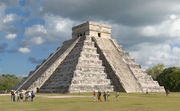
Campfire remains in the Valley of Mexico have been radiocarbon-dated to 21,000 BCE, and a few chips of stone tools have been found near the hearths, indicating the presence of humans at that time.[37] Around 9,000 years ago, ancient indigenous peoples domesticated corn and initiated an agricultural revolution, leading to the formation of many complex civilizations. Between 1,800 and 300 BCE, many matured into advanced pre-Columbian Mesoamerican civilizations such as: the Olmec, the Teotihuacan, the Maya, the Zapotec, the Mixtec, the Toltec and the Aztec, which flourished for nearly 4,000 years before the first contact with Europeans.
These civilizations are credited with many inventions and advancements in fields such as architecture (pyramid-temples), mathematics, astronomy, medicine and theology. The Aztecs were noted for practicing human sacrifice on a large scale.[38] At its peak, Teotihuacan, containing some of the largest pyramidal structures built in the pre-Columbian Americas, had a population of more than 150,000 people.[39] Estimates of the population before the Spanish conquest range from 6 million to 25 million.[40][41]

In the early 16th century, from the landing of Hernán Cortés, the Aztec civilization was invaded and conquered by the Spaniards.[42] Unintentionally introduced by Spanish conquerors, smallpox ravaged Mesoamerica in the 1520s, killing millions of Aztecs,[43] including the emperor, and was credited with the victory of Hernán Cortés over the Aztec empire.[44] The territory became part of the Spanish Empire under the name of New Spain. Much of the identity, traditions and architecture of Mexico were created during the colonial period.
On September 16, 1810, independence from Spain was declared by priest Miguel Hidalgo y Costilla, in the small town of Dolores, Guanajuato.[45] The first insurgent group was formed by Hidalgo, the Spanish viceregal army captain Ignacio Allende, the militia captain Juan Aldama and "La Corregidora" Josefa Ortiz de Domínguez. Hidalgo and some of his soldiers were captured and executed by firing squad in Chihuahua, on July 31, 1811. Following his death, the leadership was assumed by priest José María Morelos, who occupied key southern cities.
In 1813 the Congress of Chilpancingo was convened and, on November 6, signed the "Solemn Act of the Declaration of Independence of Northern America". Morelos was captured and executed on December 22, 1815. In subsequent years, the insurgency was near collapse, but in 1820 Viceroy Juan Ruiz de Apodaca sent an army under the criollo general Agustín de Iturbide against the troops of Vicente Guerrero. Instead, Iturbide approached Guerrero to join forces, and in 1821 representatives of the Spanish Crown and Iturbide signed the "Treaty of Córdoba" and the "Declaration of Independence of the Mexican Empire", which recognized the independence of Mexico under the terms of the "Plan of Iguala".


Agustin de Iturbide immediately proclaimed himself emperor of the First Mexican Empire. A revolt against him in 1823 established the United Mexican States. In 1824, a Republican Constitution was drafted and Guadalupe Victoria became the first president of the newly born country. The first decades of the post-independence period were marked by economic instability, which led to the Pastry War in 1836, and a constant strife between liberales, supporters of a federal form of government, and conservadores, proposals of a hierarchical form of government.[46]
General Antonio López de Santa Anna, a centralist and two-time dictator, approved the Siete Leyes in 1836, a radical amendment that institutionalized the centralized form of government. When he suspended the 1824 Constitution, civil war spread across the country, and three new governments declared independence: the Republic of Texas, the Republic of the Rio Grande and the Republic of Yucatán.
Texas successfully achieved independence and was annexed by the United States. A border dispute led to the Mexican–American War, which began in 1846 and lasted for two years; the War was settled via the "Treaty of Guadalupe-Hidalgo", which forced Mexico to give up nearly half of its land to the U.S., including California and New Mexico. A much smaller transfer of territory in parts of southern Arizona and New Mexico — the Gadsden Purchase — occurred in 1854. The Caste War of Yucatán, the Mayan uprising that began in 1847,[47] was one of the most successful modern Native American revolts.[48] Maya rebels, or Cruzob, maintained relatively independent enclaves until the 1930s.[49]
Dissatisfaction with Santa Anna's return to power led to the liberal "Plan of Ayutla", initiating an era known as La Reforma, after which a new Constitution was drafted in 1857 that established a secular state, federalism as the form of government, and several freedoms. As the conservadores refused to recognize it, the War of Reform began in 1858, during which both groups had their own governments. The war ended in 1861 with victory by the Liberals, led by Amerindian President Benito Juárez. In the 1860s Mexico underwent a military occupation by France, which established the Second Mexican Empire under the rule of Habsburg Archduke Ferdinand Maximilian of Austria with support from the Roman Catholic clergy and the conservadores, who later switched sides and joined the liberales. Maximilian surrendered, was tried on June 14 and was executed on June 19, 1867.

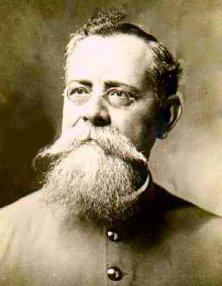
Porfirio Díaz, a republican general during the French intervention, ruled Mexico from 1876–1880 and then from 1884–1911 in five consecutive reelections, period known as the Porfiriato, characterized by remarkable economic achievements, investments in arts and sciences, but also of economic inequality and political repression.[50]
20th century
A likely electoral fraud that led to Diaz's fifth reelection sparked the 1910 Mexican Revolution, initially led by Francisco I. Madero.
Díaz resigned in 1911 and Madero was elected president but overthrown and murdered in a coup d'état two years later directed by conservative general Victoriano Huerta. That event re-ignited the civil war, involving figures such as Francisco Villa and Emiliano Zapata, who formed their own forces. A third force, the constitutional army led by Venustiano Carranza, managed to bring an end to the war, and radically amended the 1857 Constitution to include many of the social premises and demands of the revolutionaries into what was eventually called the 1917 Constitution. It is estimated that the war killed 900,000 of the 1910 population of 15 million.[51][52]
Assassinated in 1920, Carranza was succeeded by another revolutionary hero, Álvaro Obregón, who in turn was succeeded by Plutarco Elías Calles. Obregón was reelected in 1928 but assassinated before he could assume power. In 1929, Calles founded the National Revolutionary Party (PNR), later renamed the Institutional Revolutionary Party (PRI), and started a period known as the Maximato, which ended with the election of Lázaro Cárdenas, who implemented many economic and social reforms, and most significantly expropriated the oil industry into PEMEX on March 18, 1938, but sparked a diplomatic crisis with the countries whose citizens had lost businesses by Cárdenas' radical measure.
Between 1940 and 1980, Mexico experienced a substantial economic growth that some historians call the "Mexican Miracle".[53] Although the economy continued to flourish, social inequality remained a factor of discontent. Moreover, the PRI rule became increasingly authoritarian and at times oppressive[54] (i.e.: the 1968 Tlatelolco massacre,[55] which claimed the life of around 30–800 protesters).[56]

Electoral reforms and high oil prices followed the administration of Luis Echeverría,[57][58] mismanagement of these revenues led to inflation and exacerbated the 1982 Crisis. That year, oil prices plunged, interest rates soared, and the government defaulted on its debt. President Miguel de la Madrid resorted to currency devaluations which in turn sparked inflation.

In the 1980s the first cracks emerged in PRI's monopolistic position. In Baja California, Ernesto Ruffo Appel was elected as governor. In 1988, electoral fraud prevented leftist candidate Cuauhtémoc Cárdenas from winning the national presidential elections, giving Carlos Salinas de Gortari the Presidency and leading to massive protests in Mexico City.[59]
Salinas embarked on a program of neoliberal reforms which fixed the exchange rate, controlled inflation and culminated with the signing of the North American Free Trade Agreement (NAFTA), which came into effect on January 1, 1994. The same day, the Zapatista Army of National Liberation (EZLN) started a two-week-long armed rebellion against the federal government, and has continued as a non-violent opposition movement against neoliberalism and globalization.
In December 1994, a month after Salinas was succeeded by Ernesto Zedillo, the Mexican economy collapsed, with a rapid rescue packaged authorized by U.S. President Bill Clinton and major macroeconomic reforms started by president Zedillo, the economy rapidly recovered and growth peaked at almost 7% by the end of 1999.[60]
In 2000, after 71 years, the PRI lost a presidential election to Vicente Fox of the opposition National Action Party (PAN). In the 2006 presidential elections, Felipe Calderón from the PAN was declared the winner, with a razor-thin margin over leftist politician Andrés Manuel López Obrador of the Party of the Democratic Revolution (PRD). López Obrador, however, contested the election and pledged to create an "alternative government".[61]
Administrative divisions
 Gulf of
Mexico |
The United Mexican States are a federation of thirty-one free and sovereign states, which form a union that exercises jurisdiction over the Federal District and other territories. Each state has its own Constitution and Congress, as well as a judiciary, and its citizens elect by direct voting, a governor for a six-year term, as well as representatives to their respective unicameral state congresses, for three-year terms.[62]
The states are also divided into municipalities, the smallest administrative political entity in the country, governed by a mayor or municipal president (Presidente municipal), elected by its residents by plurality.[63] Municipalities can be further subdivided into non-autonomous boroughs or in semi-autonomous auxiliary presidencies.
Constitutionally, Mexico City, as the capital and seat of the federal powers, is the Federal District, a special political division that belongs to the federation as a whole and not to a particular state, and as such, has more limited local rule than the nation's states.[64] Since 1987, it has progressively gained a greater degree of autonomy, and residents now elect a head of government and representatives of a Legislative Assembly directly. Unlike the states, the Federal District does not have a Constitution but a Statute of Government. Mexico City is coterminous and coextensive with the Federal District.
| Administrative Divisions of Mexico | |||||||
|---|---|---|---|---|---|---|---|
| State | Capital | State | Capital | State | Capital | State | Capital |
| Aguascalientes | Mexico City | Cuernavaca | Culiacán | ||||
| Mexicali | Durango | Tepic | Hermosillo | ||||
| La Paz | Guanajuato | Monterrey | Villahermosa | ||||
| Campeche | Chilpancingo | Oaxaca | Ciudad Victoria | ||||
| Tuxtla Gutiérrez | Pachuca | Puebla | Tlaxcala | ||||
| Chihuahua | Guadalajara | Querétaro | Xalapa | ||||
| Saltillo | Toluca | Chetumal | Mérida | ||||
| Colima | Morelia | San Luis Potosí | Zacatecas | ||||
Geography and climate

Mexico is located at about 23° N and 102° W[65] in the southern portion of North America.[66][67] Almost all of Mexico lies in the North American Plate, with small parts of the Baja California peninsula on the Pacific and Cocos Plates. Geophysically, some geographers include the territory east of the Isthmus of Tehuantepec (around 12% of the total) within Central America.[68] Geopolitically, however, Mexico is entirely considered part of North America, along with Canada and the United States.[69][70]
Mexico's total area is 1,972,550 km2 (761,606 sq mi), making it the world's 14th largest country by total area, and includes approximately 6,000 km2 (2,317 sq mi) of islands in the Pacific Ocean (including the remote Guadalupe Island and the Revillagigedo Islands), Gulf of Mexico, Caribbean, and Gulf of California. On its north, Mexico shares a 3,141 km (1,952 mi) border with the United States. The meandering Río Bravo del Norte (known as the Rio Grande in the United States) defines the border from Ciudad Juárez east to the Gulf of Mexico. A series of natural and artificial markers delineate the United States-Mexican border west from Ciudad Juárez to the Pacific Ocean. On its south, Mexico shares an 871 km (541 mi) border with Guatemala and a 251 km (156 mi) border with Belize.
Topography
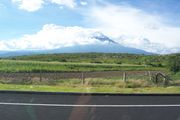

Mexico is crossed from north to south by two mountain ranges known as Sierra Madre Oriental and Sierra Madre Occidental, which are the extension of the Rocky Mountains from northern North America. From east to west at the center, the country is crossed by the Trans-Mexican Volcanic Belt also known as the Sierra Nevada. A fourth mountain range, the Sierra Madre del Sur, runs from Michoacán to Oaxaca.[71]
As such, the majority of the Mexican central and northern territories are located at high altitudes, and the highest elevations are found at the Trans-Mexican Volcanic Belt: Pico de Orizaba (5,700 m, 18,701 ft), Popocatépetl (5,462 m, 17,920 ft) and Iztaccíhuatl (5,286 m, 17,343 ft) and the Nevado de Toluca (4,577 m, 15,016 ft). Three major urban agglomerations are located in the valleys between these four elevations: Toluca, Greater Mexico City and Puebla.[71]
Climate


The Tropic of Cancer effectively divides the country into temperate and tropical zones. Land north of the twenty-fourth parallel experiences cooler temperatures during the winter months. South of the twenty-fourth parallel, temperatures are fairly constant year round and vary solely as a function of elevation. This gives Mexico one of the world's most diverse weather systems.
Areas south of the twenty-fourth parallel with elevations up to 1,000 m (3,281 ft) (the southern parts of both coastal plains as well as the Yucatán Peninsula), have a yearly median temperature between 24 to 28 °C (75.2 to 82.4 °F). Temperatures here remain high throughout the year, with only a 5 °C (9 °F) difference between winter and summer median temperatures. Both Mexican coasts, except for the south coast of the Bay of Campeche and northern Baja, are also vulnerable to serious hurricanes during the summer and fall. Although low-lying areas north of the twentieth-fourth parallel are hot and humid during the summer, they generally have lower yearly temperature averages (from 20 to 24 °C or 68 to 75.2 °F) because of more moderate conditions during the winter.
Many large cities in Mexico are located in the Valley of Mexico or in adjacent valleys with altitudes generally above 2,000 m (6,562 ft). This gives them a year-round temperate climate with yearly temperature averages (from 16 to 18 °C or 60.8 to 64.4 °F) and cool nighttime temperatures throughout the year.
Many parts of Mexico, particularly the north, have a dry climate with sporadic rainfall while parts of the tropical lowlands in the south average more than 2,000 mm (78.7 in) of annual precipitation. For example, many cities in the north like Monterrey, Hermosillo, and Mexicali experience temperatures of 40 °C (104 °F) or more in summer. In the Sonoran desert temperatures reach 50 °C (122 °F) or more. Northern Mexico is characterized by desert because it is located in a latitude where all deserts around the globe are formed.[72]
Biodiversity


Mexico is one of the 18 megadiverse countries of the world. With over 200,000 different species, Mexico is home of 10–12% of the world's biodiversity.[73] Mexico ranks first in biodiversity in reptiles with 707 known species, second in mammals with 438 species, fourth in amphibians with 290 species, and fourth in flora, with 26,000 different species.[74] Mexico is also considered the second country in the world in ecosystems and fourth in overall species.[75] Approximately 2,500 species are protected by Mexican legislations.[75]
The Mexican government created the National System of Information about Biodiversity, in order to study and promote the sustainable use of ecosystems. Deforestation is one of the most serious environmental issues in Mexico, with more than one million hectares of forest being lost each year. As of 2002, Mexico had the second fastest rate of deforestation in the world, second only to Brazil.[76] The government has taken another initiative in the late 1990s to expand the people's knowledge, interest and use of the country's esteemed biodiversity, through the Comisión Nacional para el Conocimiento y Uso de la Biodiversidad.
In Mexico, 170,000 square kilometres (65,637 sq mi) are considered "Protected Natural Areas." These include 34 reserve biospheres (unaltered ecosystems), 64 national parks, 4 natural monuments (protected in perpetuity for their aesthetic, scientific or historical value), 26 areas of protected flora and fauna, 4 areas for natural resource protection (conservation of soil, hydrological basins and forests) and 17 sanctuaries (zones rich in diverse species).[73]
The discovery of the Americas brought to the rest of the world many widely used food crops and edible plants. Some of Mexico's native culinary ingredients include: chocolate, avocado, tomato, maize, vanilla, guava, chayote, epazote, camote, jícama, nopal, zucchini, tejocote, huitlacoche, sapote, mamey sapote, many varieties of beans, and an even greater variety of chiles, such as the Habanero and the Xalapeño. Most of these names come from indigenous languages like Nahuatl.
Government and politics
| Mexico |
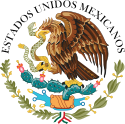 This article is part of the series: |
|
|
|
Executive
Legislative
Judiciary
Elections
Political parties
General
|
|
Other countries · Atlas |

The United Mexican States are a federation whose government is representative, democratic and republican based on a presidential system according to the 1917 Constitution. The constitution establishes three levels of government: the federal Union, the state governments and the municipal governments. All officials at the three levels are elected by voters through first-past-the-post plurality, proportional representation or are appointed by other elected officials.
The federal government is constituted by the Powers of the Union, the three separate branches of government:
Legislature
Legislative: the bicameral Congress of the Union, composed of a Senate and a Chamber of Deputies, which makes federal law, declares war, imposes taxes, approves the national budget and international treaties, and ratifies diplomatic appointments.[77]
Executive
Executive: the President of the United Mexican States, who is the head of state and government, as well as the commander-in-chief of the Mexican military forces. The President also appoints the Cabinet and other officers. The President is responsible for executing and enforcing the law, and has the authority of vetoing bills.[78]
Judiciary

Judiciary: The Supreme Court of Justice, comprised by eleven judges appointed by the President with Senate approval, who interpret laws and judge cases of federal competency. Other institutions of the judiciary are the Electoral Tribunal, collegiate, unitary and district tribunals, and the Council of the Federal Judiciary.[79]
All elected executive officials are elected by plurality (first-past-the-post). Seats to federal and state legislatures are elected by a system of parallel voting that includes plurality and proportional representation.[80] The Chamber of Deputies of the Congress of the Union is conformed by 300 deputies elected by plurality and 200 deputies by proportional representation with closed party lists[81] for which the country is divided into 5 electoral constituencies or circumscriptions.[82]
The Senate is conformed by a total of 128 senators: 64 senators, two for each state and two for the Federal District, elected by plurality in pairs; 32 senators assigned to the first minority or first-runner up (one for each state and one for the Federal District), and 32 are assigned by proportional representation with closed party lists for which the country conforms a single electoral constituency.[81]
According to the constitution, all constituent states of the federation must have a republican form of government composed of three branches: the executive, represented by a governor and an appointed cabinet, the legislative branch constituted by a unicameral congress and the judiciary, which will include called state Supreme Court of Justice. They also have their own civil and judicial codes.
In the 2009–2012 Congress of the Union, seven parties are therein represented; four of them, however, have not received neither in this nor in previous congresses more than 4% of the national votes.[83] The other three parties have historically been the dominant parties in Mexican politics:
 National Action Party (Partido Acción Nacional, PAN): a right-wing conservative party founded in 1939. PAN has gained plurality, but not absolute majority in several parliamentary elections. In 2000, it gained the presidency for the first time. It belongs to the Christian Democrat Organization of America.[84]
National Action Party (Partido Acción Nacional, PAN): a right-wing conservative party founded in 1939. PAN has gained plurality, but not absolute majority in several parliamentary elections. In 2000, it gained the presidency for the first time. It belongs to the Christian Democrat Organization of America.[84] Institutional Revolutionary Party (Partido Revolucionario Institucional, PRI): a center-left party that ascribes to social democracy—it is a member of Socialist International—[85] founded in 1929 to unite all the factions of the Mexican Revolution. Prominent left-wing Mexican politicians have been members of the party. Having dominated Mexican politics since the Revolution, PRI includes diverse factions including some center-right members.
Institutional Revolutionary Party (Partido Revolucionario Institucional, PRI): a center-left party that ascribes to social democracy—it is a member of Socialist International—[85] founded in 1929 to unite all the factions of the Mexican Revolution. Prominent left-wing Mexican politicians have been members of the party. Having dominated Mexican politics since the Revolution, PRI includes diverse factions including some center-right members. Party of the Democratic Revolution (Partido de la Revolución Democrática, PRD): a left-wing party,[86] founded in 1989 as the successor of the coalition of socialists and liberal parties, the National Democratic Front that had presented the candidacy of Cuauhtémoc Cárdenas in the controversial 1988 elections.
Party of the Democratic Revolution (Partido de la Revolución Democrática, PRD): a left-wing party,[86] founded in 1989 as the successor of the coalition of socialists and liberal parties, the National Democratic Front that had presented the candidacy of Cuauhtémoc Cárdenas in the controversial 1988 elections.
The PRI held an almost hegemonic power in Mexican politics since 1929. Since 1977 consecutive electoral reforms allowed opposition parties to win more posts at the local and federal level. This process culminated in the 2000 presidential elections in which Vicente Fox, candidate of the PAN, became the first non-PRI president to be elected in 71 years.
In 2006, Felipe Calderón of the PAN faced Andrés Manuel López Obrador of the PRD in a very close election (0.58% difference), by simple plurality—the Mexican electoral system does not include runoff voting. López Obrador contested the elections, but on September 6, 2006, Felipe Calderón was declared President-elect by the Electoral Tribunal. His cabinet was sworn in at midnight on December 1, 2006 and Calderón was handed the presidential band by outgoing Vicente Fox at Los Pinos. He was officially sworn as President on the morning of December 1, 2006 in Congress.
Foreign relations

The foreign relations of Mexico are directed by the President of the United Mexican States[87] and managed through the Ministry of Foreign Affairs.[88] The principles of the foreign policy are constitutionally recognized in the Article 89, Section 10, which include: respect for international law and legal equality of states, their sovereignty and independence, non-intervention in the domestic affairs of other countries, peaceful resolution of conflicts, and promotion of collective security through active participation in international organizations.[87] Since the 1930s, the Estrada Doctrine has served as a crucial complement to these principles.[89]
After the War of Independence, the relations of Mexico were focused primarily on the United States, its northern neighbor, largest trading partner,[90] and the most powerful actor in hemispheric and world affairs,[91] as well as on its historically-tied neighbors in Latin America and the Caribbean. Due to domestic issues in the early 1900s, Mexico was kept isolated from international affairs. Once the order was reestablished, its foreign policy was built under hemispheric prestige in subsequent decades.

Demonstrating independence from the U.S., Mexico supported the Cuban government since its establishment in the early 1960s,[92] the Sandinista revolution in Nicaragua during the late 1970s,[93] and leftist revolutionary groups in El Salvador during the 1980s.[94] In the 2000s, former President Vicente Fox adopted a new foreign policy that calls for an openness and an acceptance of criticism from the international community and the increase of Mexican involvement in foreign affairs, as well as a further integration towards its northern neighbors.[95] A greater priority to Latin America and the Caribbean has been given in the administration of President Felipe Calderón.[96]
Mexico is one of the founding members of several international organizations, most notably the United Nations,[97] the Organization of American States,[98] the Organization of Ibero-American States,[99] the OPANAL[100] and the Rio Group.[101] For a long time, Mexico has been one of the largest contributors to the United Nations regular budget, in 2008 over 40 million dollars were given to the organization.[102] In addition, it is has been the only Latin American member of the Organisation for Economic Co-operation and Development since it joined in 1994 though Chile is in the process of gaining full membership.[103][104] Mexico is considered as a newly industrialized country,[17][18] a regional power[105][106] and an emerging market,[107] hence its presence in major economic groups such as the G8+5 and the G-20. In addition, since the 1990s Mexico has sought a reform of the United Nations Security Council and its working methods[108] with the support of Canada, Italy, Pakistan and other nine countries, which form a group informally called the Coffee Club.[109]
Military



The Mexican Armed Forces (Fuerzas Armadas de Mexico) are composed of the Mexican Army which includes the Mexican Air Force (FAM) as a subordinate entity and the Mexican Navy which also includes the Mexican Naval Infantry and Naval Aviation (FAN). Its three objectives are the repulsion of external aggressions, protection of internal security, and to aid the civilian population in case of natural disaster. All active combatant units are made up entirely of career soldiers, and although National Military Service does exist conscripts are only integrated into reserve units. Mexico's active combat troops add up to 396,000 not including non-combatant military personnel (mechanics, engineers, medics etc.). The total number of military personnel with full training when counting reserve forces and national guard units is 5.3 million total, although Mexico's available manpower potential in all out war is estimated at over 73 million by the CIA.
Mexico has the third-largest defense budget in Latin America, with reported annual military expenditures of US $24.944 billion or about 1.6% of GDP, although the CIA believes that Mexico does not report it's full military budget and that Mexico's true annual military budget could be significantly higher, similar to the united state's black budget.Since the 1990s, when the military escalated its role in the war on drugs, increasing importance has been placed on acquiring airborne surveillance platforms, aircraft, helicopters, digital war-fighting technologies,[110] urban warfare equipment and rapid troop transport.[111]
The Mexican Military has two branches: the Mexican Army (which includes the Mexican Air Force), and the Mexican Navy. The Mexican armed forces maintain significant infrastructure, including facilities for design, research, and testing of weapons, vehicles, aircraft, naval vessels, defense systems and electronics;[110][112] military industry manufacturing centers for building such systems, and advanced naval dockyards that build heavy military vessels and advanced missile technologies.[113]
These facilities have a significant employment and economic impact. In recent years, Mexico has improved its training techniques, military command and information structures and has taken steps to becoming more self-reliant in supplying its military by designing as well as manufacturing its own arms,[114] missiles,[112] aircraft,[115] vehicles, heavy weaponry, electronics,[110] defense systems,[110] armor, heavy military industrial equipment and heavy naval vessels.[116]
Historically, Mexico has remained neutral in international conflicts[117] with the exception of World War II. However, in recent years some political parties have proposed an amendment of the Constitution in order to allow the Mexican army, air force or navy to collaborate with the United Nations in peacekeeping missions, or to provide military help to countries that officially ask for it.[118]
Law enforcement

Public security is enacted at the three levels of government, each of which has different prerogatives and responsibilities. Local and state police department are primarily in charge of law enforcement, whereas the Mexican Federal Police is in charge of specialized duties. All levels report to the Secretaría de Seguridad Pública (Secretariat of Public Security). The General Attorney's Office (Procuraduría General de la República, PGR) is the executive power's agency in charge of investigating and prosecuting crimes at the federal level, mainly those related to drug and arms trafficking,[119] espionage, and bank robberies.[120] The PGR operates the Federal Investigations Agency (Agencia Federal de Investigación, AFI) an investigative and preventive agency.[121]
While the government respects the human rights of most citizens,[122] serious abuses of power have been reported in security operations in indigenous communities and poor urban neighborhoods.[122] The National Human Rights Commission has had little impact in reversing this trend, engaging mostly in documentation but failing to use its powers to issue public condemnations to the officials who ignore its recommendations.[123] By law, all defendants have the rights that assure them fair trials and human treatment; however, the system is overburdened and overwhelmed with several problems.[124]
Despite the efforts of the authorities to fight crime and fraud, few Mexicans have strong confidence in the police or the judicial system, and therefore, few crimes are actually reported by the citizens.[124] In 2008, president Calderón proposed a major reform of the judicial system, which was approved by the Congress of the Union, which included oral trials, the presumption of innocence for defendants, the authority of local police to investigate crime—until then a prerogative of special police units—and several other changes intended to speed up trials.[125]
Crime
Total crimes per capita average 12 per 1,000 people in Mexico, ranking 39 in a survey of 60 countries.[126] Violent crime is a critical issue in Mexico; with a rate of homicide varying from 11 to 14 per 100,000 inhabitants.[127] Drug-traffic and narco-related activities are a major concern in Mexico.[128] The Mexican drug cartels have as many as 100,000 active personnel. Drug cartels are active in the shared border with the US and police corruption and collusion with drug cartels is a crucial problem.[127]
Current president Felipe Calderón made abating drug-trafficking one of the top priorities of his administration. In a very controversial move, Calderón deployed military personnel to cities where drug cartels operate. While this move has been criticized by the opposition parties and the National Human Rights Commission, its effects have been praised by the Bureau for International Narcotics and Law Enforcement Affairs as having obtained "unprecedented results..." with "many important successes".[129] In October 2007, the president Calderón and US president George W. Bush announced the Mérida Initiative a historic plan of law enforcement cooperation between the two countries.[130]
Economy
| Economy of Mexico | |
|---|---|
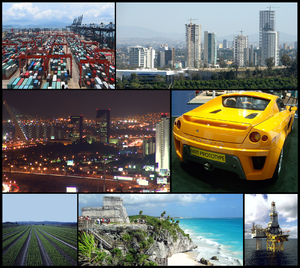 Aspects of Mexican economy |
|
| Rank | 11th |
| Currency | Mexican peso (MXN, $) |
| Fiscal year | calendar |
| Trade organisations | APEC, CARICOM, NAFTA, OECD and WTO |
| Statistics | |
| GDP | $1.563 Trillion[131] (2008) |
| GDP growth | 4.8% (2009) |
| GDP per capita | $14,932 (2009 est.)[132] |
| GDP by sector | agriculture: 4%, industry: 26.6%, services: 69.5% (2007 est.) |
| Inflation (CPI) | 2.88% (Central bank report for February 2009) |
| Population below poverty line |
4.8% using food-based definition of poverty; asset based poverty amounted at approximately 15% (December 2008) |
| Labour force | 45.38 million (2007 est.) |
| Labour force by occupation |
agriculture: 13%, industry: 29%, services: 58% (2003) |
| Unemployment | 3.7% plus considerable underemployment(21%) (2007 est.) |
| Main industries | Food and Beverages, Aerospace, Electronics, Tobacco, chemicals, Iron and Steel, Petroleum, Biotechnology, Mining, Shipbuilding, Electricity, Defense Products, Textiles, Clothing, Motor vehicles, Computers, consumer durables, Information Technologies, Tourism and Ecotourism |
| External | |
| Exports | $419.9 billion f.o.b. (2008 est.) |
| Export goods | Manufactured goods, electronics, automobiles, oil and oil products, aircraft, silver, computers and servers, fruits, meats, consumer electronics, processed foods, vegetables, ships, coffee, LCD screens, electricity, biotechnology, cotton, rolling stock, automotive and aircraft enigines, cellular phones, metals, industrial equipment, granite and marble, lithium, batteries, firearms, aluminium, information technologies, foodstuffs, silicone, medical technology, gold, plastics, microproccesors, |
| Main export partners | United States 49.2%, Germany 15%, South Korea 12.5% China 10.3% Chile 8.4% (2008) |
| Imports | $283 billion f.o.b. (2007 est.) |
| Main import partners | United States 44.3%, Brazil 31.5%, Chile 9.3%, China 5.5%, South Korea 5.3%, Japan 4.1% (2008) |
| Public finances | |
| Public debt | $92.7 billion (October 2008) |
| Revenues | $571.2 billion (2008) |
| Expenses | $321.2 billion (2000 est.) |
| Economic aid | $189.4 million (2008) |
| Main data source: CIA World Fact Book All values, unless otherwise stated, are in US dollars |
|

The economy of Mexico is the 11th largest in the world. Since the 1994 crisis, administrations have improved the country's macroeconomic fundamentals. Mexico was not significantly influenced by the recent 2002 South American crisis, and has maintained positive rates of growth after a brief period of stagnation in 2001. Moody's (in March 2000) and Fitch IBCA (in January 2002) issued investment-grade ratings for Mexico's sovereign debt. In spite of its unprecedented macroeconomic stability, which has reduced inflation and interest rates to record lows and has increased per capita income, enormous gaps remain between the urban and the rural population, the northern, central, and southern states, and the rich and the poor although there has been a large growing middle class since the mid 1990's.[133] Some of the government's challenges include the upgrade of infrastructure, the modernization of the tax system and labor laws, and the reduction of income inequality.
The economy contains rapidly developing modern industrial and service sectors, with increasing private ownership. Recent administrations have expanded competition in ports, railroads, telecommunications, electricity generation, natural gas distribution and airports, with the aim of upgrading infrastructure. As an export-oriented economy, more than 90% of Mexican trade is under free trade agreements (FTAs) with more than 40 countries, including the European Union, Japan, Israel, and much of Central and South America.
The most influential FTA is the North American Free Trade Agreement (NAFTA), which came into effect in 1994, and was signed in 1992 by the governments of the United States, Canada and Mexico. In 2006, trade with Mexico's two northern partners accounted for almost 50% of its exports and 45% of its imports.[134] Recently, the Congress of the Union approved important tax, pension and judicial reforms, and reform to the oil industry is currently being debated. According to the Forbes Global 2000 list of the world's largest companies in 2008, Mexico had 16 companies in the list.[135]
Mexico has a free market mixed economy, and is firmly established as an upper middle-income country.[16] It is the 11th largest economy in the world as measured in gross domestic product in purchasing power parity.[136] According to the latest information available from the International Monetary Fund, Mexico had the second-highest Gross National Income per capita in Latin America in nominal terms, at $9,716 in 2007, and the highest in purchasing power parity (PPP), at $14,119 in 2007.[136]
After the 1994 economic debacle, Mexico has made an impressive recovery, building a modern and diversified economy.[16] Oil is Mexico's largest source of foreign income.[137] According to Goldman Sachs, BRIMC review of emerging economies, by 2050 the largest economies in the world will be as follows: China, India, United States, Brazil and Mexico.[138] Mexico is the largest North American auto producing nation, recently surpassing Canada and U.S.[139]
Mexico is the first and only Latin American country to be included in the World Government Bond Index or WGBI, which list the most important global economies that circulate government debt bonds.[140]
According to the director for Mexico at the World Bank, the population in poverty has decreased from 24.2% to 17.6% in the general population and from 42% to 27.9% in rural areas from 2000 to 2004.[141] As of January 2009 4.6% of the population is impoverished if measured by food based poverty and 15% of the population is considered to be impoverished by asset based measurments (living on less than $10,000 per year).
Nonetheless, income inequality remains a problem, and huge gaps remain not only between rich and poor but also between the north and the south, and between urban and rural areas. Sharp contrasts in income and Human Development are also a grave problem in Mexico. The 2004 United Nations Human Development Index report for Mexico states that Benito Juárez, a district of Mexico City, and San Pedro Garza García, in the State of Nuevo León, would have a similar level of economic, educational and life expectancy development to Germany or New Zealand. In contrast, Metlatonoc, in the state of Guerrero, would have an HDI similar to that of Syria.[142] According to a 2008 UN report the average income in a typical urbanized area of Mexico was $26,654 a rate higher than advanced nations like South Korea or Taiwan while the average income in rural areas (sometimes just miles away) was only $8,403, rate comparable to developing countries such as Russia or Turkey.[143]
GDP annual average growth for the period of 1995–2002 was 5.1%.[58] The economic downturn in the United States also caused a similar pattern in Mexico, from which it rapidly recovered to grow 4.1% in 2005 and 3% in 2005. Inflation has reached a record low of 3.3% in 2005, and interest rates are low, which have spurred credit-consumption in the middle class. Mexico has experienced in the last decade monetary stability: the budget deficit was further reduced and foreign debt was decreased to less than 20% of GDP.[58] Along with Chile, Mexico has the highest rating of long-term sovereign credit in Latin America.
The remittances from Mexican citizens working in the United States account for only 0.2% of Mexico's GDP[144] which was equal to US$20 billion dollars per year in 2004 and is the tenth largest source of foreign income after oil, industrial exports, manufactured goods, electronics, heavy industry, automobiles, construction, food, banking and financial services.[145] According to Mexico's central bank, remittances in 2008 amounted to $25bn.[146]
Ongoing economic concerns include the commercial and financial dependence on the US,[147] low real wages, underemployment for a large segment of the population, inequitable income distribution (the top 32% of income earners account for 55% of income), and few advancement opportunities for the largely Mayan population in the southern states.
Hourly minimum wages are set annually by law and determined by zone; $57.46 Mexican pesos ($4.52 USD) in Zona A (Baja California, Federal District, State of Mexico, and large cities), $55.84 Mexican pesos ($4.39USD) in Zone B (Sonora, Nuevo León, Tamaulipas, Veracruz, and Jalisco), and $54.47 Mexican pesos ($4.29 USD)in Zone C (all other states)[148]
Industry

Among the most important industrial manufacturers in Mexico is the automotive industry, whose standards of quality are internationally recognized. The automobile sector in Mexico differs from that in other Latin American countries and developing nations in that it does not function as a mere assembly manufacturer. In 2007 one out every seven cars sold was made in Mexico.[149] The industry produces technologically complex components and engages in some research and development activities.[150] The "Big Three" (General Motors, Ford and Chrysler) have been operating in Mexico since the 1930s, while Volkswagen and Nissan built their plants in the 1960s.[151]
Later, Toyota, Honda, BMW, and Mercedes-Benz established a presence. Given the high requirements of North American components in the industry, many European and Asian parts suppliers have also moved to Mexico: in Puebla alone, 70 industrial part-makers cluster around Volkswagen.[150] The relatively small domestic car industry is represented by DINA Camiones S.A. de C.V., which has built buses and trucks for almost half a century,[152] and the new Mastretta company that builds the high performance Mastretta MXT sports car.[153]
The electronics industry of Mexico has grown enormously within the last decade. In 2007 Mexico surpassed South Korea as the second largest manufacturer of televisions,[149] and in 2008 Mexico surpassed China, South Korea and Taiwan to become the largest producer of smartphones in the world.[149] There are almost half a million (451,000) students enrolled in electronics engineering programs[154] with an additional 90,000 students graduating from electronics engineering and technical programs each year and Mexico had over half a million (580,000) certified IT professionals employed in 2007.[149] In 2005, according to the World Bank, high-tech industrial production represented 19.6% of Mexico's economy.[155]
Some large industries of Mexico include Cemex, the third largest cement and construction conglomerate in the world;[156] the alcohol beverage industries, including world-renowned players like Grupo Modelo; conglomerates like FEMSA, which apart from owning breweries and the OXXO convenience store chain, is also the second-largest Coca-Cola bottler in the world; Gruma, the largest producer of corn flour and tortillas in the world; and Grupo Bimbo, Telmex, Televisa, among many others. Mexico is the second largest producer or silver and precious metals.[149]


Maquiladoras (Mexican factories which take in imported raw materials and produce goods for export) have become the landmark of trade in Mexico. This sector has benefited from NAFTA, in that real income in the maquiladora sector has increased 15.5% since 1994, though from the non-maquiladora sector has grown much faster.[151] Contrary to popular belief, this should be no surprise since maquiladora's products could enter the US duty free since the 1960s industry agreement. Other sectors now benefit from the free trade agreement, and the share of exports from non-border states has increased in the last 5 years while the share of exports from maquiladora-border states has decreased. As a result of this process Mexico is the worlds third largest maker of refrigerators and white goods, after China and Brazil.[158]
Currently Mexico is focusing in developing an aerospace industry and the manufacture and design of helicopter and commercial jet aircraft is taking place.[159] Foreign firms such as MD Helicopters and Bombardier build helicopters and commercial jets respectively in Mexico.[160][161] Although the Mexican aircraft industry is mostly foreign, as is its car industry, Mexican firms have been founded such as Aeromarmi, which builds light propeller airplanes, and Hydra Technologies, which builds Unmanned Aerial Vehicles. More aircraft companies have operations in Mexico than any other country with a record breaking 214 full process aircraft corporations established in Mexico and Since 1990 Mexico has been the largest destination for foreign companies to design, manufacture, and service aircraft.[149]
As compared with the United States or countries in Western Europe, a larger sector of Mexico's industrial economy is food manufacturing, which includes several world class companies; but the regional industry is undeveloped. There are national brands that have become international, and local Mom and Pop producers, but little manufacturing in between.
Tourism

According to the World Tourism Organization, Mexico has one of the largest tourism industries in the world. In 2005 it was the seventh most popular. >Mexico is the twenty-third highest tourism spender in the world, and the highest in Latin America.[162] The most visited attractions are the Meso-American ruins, colonial cities, and especially the beach resorts.[163] The nation's temperate climate and unique culture – a fusion of the European (particularly Spanish) and the Meso-American – also make Mexico an attractive destination. The peak tourism seasons in the country are during December and the mid-Summer, with brief surges during the week before Easter and the Spring break, when many of the beach resort sites become popular destinations for college students from the United States. The vast majority of tourists come to Mexico from the United States and Canada. Many other visitors come from Europe and Asia. A small number of tourists also come from other Latin American countries.[164]
There is also a burgeoning domestic tourism trade as a growing affluent middle class begins to vacation within their own country. While Mexico's middle/lower class usually promotes national tourism, the middle/higher class usually prefers to travel overseas.

In terms of the 2008 Travel and Tourism Competitiveness Index (TTCI), which is a measurement of the factors that make it attractive to developing business in the travel and tourism industry of individual countries, Mexico reached the 57th place in the world's ranking, the fifth among Latin American countries, and the ninth in the Americas.[165] In considering simply the subindex measuring human, cultural, and natural resources, Mexico ranks in the 19th place on a worldwide level, and 25th for both the natural resources criteria and the cultural criteria.

The capital of Mexico, Mexico City is the most popular with tourists as an ancient Meso-American city and the site of many popular tourist attractions such as the Pyramid of the Sun and the Pyramid of the Moon. Other human-made tourist zones, such as the La Zona Rosa or Shopping District, El Palenque and El Zócalo (one of the largest public plazas in the world) are here. The city is also home to the Plaza de toros México – the world's largest bullring – and to the Mexican National Palace, built on the site of Montezuma's palace, and the huge Metropolitan Cathedral, the largest in the Western Hemisphere, built over the even greater Temple of Teocalli. Mexico City features also one of the highest esteemed museums in the world: the National Museum of Anthropology and History.
Guadalajara, Jalisco, the second-largest city by population in the Republic, is home of some of Mexico's best known traditions, such as tequila, mariachi music and charros, or Mexican cowboys. Its similitude with western European countries mixed with modern architecture and infrastructure makes Guadalajara very attractive to tourists. Along with Mexico City and beach destinations (Cancun, Acapulco, etc.), Guadalajara is one of the most visited cities in Mexico. Cultural tourism is the main attraction, the city being home to a large number of museums, art galleries and theatres.

The city is also the host of several internationally-renowned events, such as the Guadalajara International Book Fair which is the most important exposition of its kind in the Spanish-speaking world, and the second largest book fair in the world.[166] The city is known as a pioneer in the underground arts scene as well as in the electronic music world, another main touristic attraction. Its diversity of European architectural styles is a focus of attraction for tourists, in particular the Metropolitan Cathedral, the Degollado Theatre and the Hospicio Cabañas which is a World Heritage Site and one of the oldest hospital complexes in Spanish America. Other tourism activities include shopping at its world class shopping malls, or plazas, taking a tour to the surrounding areas such as the Huentitan Canyon, Tonalá, Tlaquepaque, Chapala or visiting nearby towns, which are well-connected by modern highways, such as Tequila (the home of the heavenly liquid), Puerto Vallarta or Mazamitla, depending upon whether the visitor wishes to visit a colored bohemian and cultural town, a world-destination beach or stay in a cabin in the middle of the forest.
Monterrey, Nuevo Leon, was founded in the late 1500s. The downtown district is the oldest section in the city, surrounded by newer neighbourhoods. The Museo de Historia Mexicana (Museum of Mexican History), MARCO (Monterrey Museum of Contemporary Art), Metropolitan Museum of Monterrey and the Museum of the Palacio de Gobierno, or State House, are some of the better known museums in the city, as well as nationally. The Santa Lucia Riverwalk is a popular tourist site, connecting the Fundidora Park with the Macroplaza, one of the largest plazas in the world.
Energy

Energy production in Mexico is managed by state-owned companies: the Federal Commission of Electricity (Comisión Federal de Electricidad, CFE) and Pemex (Petróleos Mexicanos). The CFE is in charge of the operation of electricity-generating plants and its distribution all across the territory. Most of the electricity is generated in thermoelectrical plants, even though CFE operates several hydroelectric plants, as well as wind power, geothermal and nuclear generators.[167]
Natural resources are the "nation's property" (i.e. public property) by constitution. As such, the oil sector is administered by the government with varying degrees of private investment. Mexico is the sixth-largest oil producer in the world, with 3.7 million barrels per day.[168]
Pemex, the public company in charge of exploration, extraction, transportation and marketing of crude oil and natural gas, as well as the refining and distribution of petroleum products and petrochemicals, has a total asset worth of $415.75 billion it is the second largest company in the world by market value as estimated by the Financial Times in 2006 although the majorty of its shares are non-publicly listed and under control of the Mexican government. It's publicly listed shares totaled $102 billion in 2010, representing approximately one quarter of the companies total worth, and[169][170] it is one of the largest companies in the world by revenue, making US $86 billion in sales a year,[171] a sum larger than the GDP of some countries. Nonetheless, the company is heavily taxed, a significant source of revenue for the government, of almost 62 per cent of the company's sales. In 1980 oil exports accounted for 61.6% of total exports; by 2000 it was only 7.3%.[150]
The two main government agencies in charge of developing renewable energy resources are SEMARNAT and SENER. The Environment and Natural Resources Secretariat (SEMARNAT) is responsible for environmental policy and the preservation of renewable and non-renewable resources, while SENER defines the national energy policy. CONAE, the National Commission for Energy Savings, is responsible for promoting energy savings and energy efficiency.

Finally, SEDESOL, the National Secretariat for Social Development, includes the promotion and use of renewable energy in some of their projects.[172] The Renewable Energy Development and Financing for Energy Transition Law (LAERFTE), which entered into force on November 28, 2008 mandated SENER to produce a [National Strategy for Energy Transition and Sustainable Energy Use and a Special Program for Renewable Energy. The Special Program contains tentative targets for renewable generation for different technologies. Those targets will be revised as SENER and CRE advance in the completion of the activities included in the law.About 19% of the electricity produced in Mexico comes from hydroelectric resources. The largest hydro plant in Mexico is the 2,400 MW Manuel Moreno Torres in Chicoasén, Chiapas, in the Grijalva river. This is the world's fourth most productive hydroelectric plant.[173] The 750 MW El Cajon hydroelectric plant in Nayarit, which started operations in November 2006, is the latest completed large project.[174] Mexico is the country with the world's third largest solar potential.[172] The country's gross solar potential is estimated at 5kWh/m2 daily, which corresponds to 50 times national electricity generation.[175] Currently, there is over 1 million square meters of solar thermal panels[176] installed in Mexico, while in 2005, there were 115,000 square meters of solar PV (photo-voltaic). It is expected that in 2012 there will be 1,8 million square meters of installed solar thermal panels.[176] Total Wind power production in Mexico, is estimated to be very high. Three main areas for wind generation have been identified: the Isthmus of Tehuantepec,in the state of Oaxaca; La Rumorosa, in the state of Baja California; The area of the Gulf of California, which includes Baja California, Baja California Sur, Sonora and Sinaloa,[177] the Yucatán Peninsula.[176] and the states of Zacatecas, Hidalgo, Veracruz.
Transportation
- See also: List of Mexican Federal Highways and List of Mexican railroads

The paved-roadway network in Mexico is the most extensive in Latin America at 116,802 km (72,577 mi) in 2005; 10,474 km (6,508 mi) were multi-lane freeways or expressways,[178] most of which were tollways. Nonetheless, Mexico's diverse orography—most of the territory is crossed by high-altitude ranges of mountains—as well as economic challenges have led to difficulties in creating an integrated transportation network and even though the network has improved, it still cannot meet national needs adequately.[179]
Being one of the first Latin American countries to promote railway development,[179] the network, though extensive at 30,952 km (19,233 mi),[180] is still inefficient to meet the economic demands of transportation.[179] Most of the rail network is mainly used for merchandise or industrial freight and was mostly operated by National Railway of Mexico (Ferrocarriles Nacionales de México, FNM), privatized in 1997.
In 1999, Mexico had 1,806 airports, of which 233 had paved runways; of these, 35 carry 97% of the passenger traffic.[180] The Mexico City International Airport remains the largest in Latin America and the 44th largest in the world[181] transporting 21 million passengers a year.[182] There are more than 30 domestic airline companies of which only two are known internationally: Aeroméxico and Mexicana.
Mass transit in Mexico is modest. Most of the domestic passenger transport needs are served by an extensive bus network[180] with several dozen companies operating by regions. Train passenger transportation between cities is limited. Inner-city rail mass transit is available at Mexico City—with the operation of the metro, elevated and ground train, as well as a Suburban Train connecting the adjacent municipalities of Greater Mexico City—as well as at Guadalajara and Monterrey, the first served by a commuter rail and the second by an underground and elevated metro.
Communications

The telecommunications industry is mostly dominated by Telmex (Teléfonos de México), privatized in 1990. As of 2006, Telmex had expanded its operations to Colombia, Peru, Chile, Argentina, Brazil and Uruguay and the United States. Other players in the domestic industry are Axtel and Maxcom. Due to Mexican orography, providing landline telephone service at remote mountainous areas is expensive, and the penetration of line-phones per capita is low compared to other Latin American countries, at forty-percent, however 82% of Mexicans over the age of 14 own a mobile phone. Mobile telephony has the advantage of reaching all areas at a lower cost, and the total number of mobile lines is almost two times that of landlines, with an estimation of 63 million lines.[183] The telecommunication industry is regulated by the government through Cofetel (Comisión Federal de Telecomunicaciones).
The Mexican satellite system is domestic and operates 120 earth stations. There is also extensive microwave radio relay network and considerable use of fiber-optic and coaxial cable.[183] Mexican satellites are operated by Satélites Mexicanos (Satmex), a private company, leader in Latin America and servicing both North and South America.[184] It offers broadcast, telephone and telecommunication services to 37 countries in the Americas, from Canada to Argentina. Through business partnerships Satmex provides high-speed connectivity to ISPs and Digital Broadcast Services.[185] Satmex maintains its own satellite fleet with most of the fleet being Mexican designed and built.
Mexico has recently emerged as a major producer of communications technology. In 2008 Mexico manufactured over 130 million mobile phones making it the sixth largest producer of mobile phones.
Usage of radio, television, and Internet in Mexico is prevalent.[180] There are approximately 1,410 radio broadcast stations and 236 television stations (excluding repeaters).[183] Major players in the broadcasting industry are Televisa—the largest Spanish media company in the Spanish-speaking world[186]—and TV Azteca.
Demographics
According to the latest official estimate, which reported a population of 111 million, Mexico is the most populous Spanish-speaking country in the world.[187] Mexican annual population growth has drastically decreased from a peak of 3.5% in 1965 to 0.99% in 2005. Life expectancy in 2006 was estimated to be at 75.4 years (72.6 male and 78.3 female). The states with the highest life expectancy are Baja California (75.9 years) and Nuevo León (75.6 years). The Federal District has a life expectancy of the same level as Baja California.
The lowest levels are found in Chiapas (72.9), Oaxaca (73.2) and Guerrero (73.2 years). The mortality rate in 1970 was 9.7 per 1000 people; by 2001, the rate had dropped to 4.9 men per 1000 men and 3.8 women per 1000 women. The most common reasons for death in 2001 were heart problems (14.6% for men 17.6% for women) and cancer (11% for men and 15.8% for women).
Mexican population is increasingly urban, with close to 75% living in cities. The five largest urban areas in Mexico (Greater Mexico City, Greater Guadalajara, Greater Monterrey, Greater Puebla and Greater Toluca) are home to 30% of the country's population. Migration patterns within the country show positive migration to north-western and south-eastern states, and a negative rate of migration for the Federal District. While the annual population growth is still positive, the national net migration rate is negative (−4.7/1000), attributable to the emigration phenomenon of people from rural communities to the United States.
Metropolitan areas
Metropolitan areas in Mexico have been traditionally defined as the group of municipalities that heavily interact with each other, usually around a core city.[188] In 2004, a joint effort between CONAPO, INEGI and the Ministry of Social Development (SEDESOL) agreed to define metropolitan areas as either:[188]
- the group of two or more municipalities in which a city with a population of at least 50,000 is located whose urban area extends over the limit of the municipality that originally contained the core city incorporating either physically or under its area of direct influence other adjacent predominantly urban municipalities all of which have a high degree of social and economic integration or are relevant for urban politics and administration; or
- a single municipality in which a city of a population of at least one million is located and fully contained, (that is, it does not transcend the limits of a single municipality); or
- a city with a population of at least 250,000 which forms a conurbation with other cities in the United States.
It should be noted, however, that northwestern and southeastern states are divided into a small number of large municipalities whereas central states are divided into a large number of smaller municipalities. As such, metropolitan areas in the northwest usually do not extend over more than one municipality (and figures usually report population for the entire municipality) whereas metropolitan areas in the center extend over many municipalities.
Few metropolitan areas extend beyond the limits of one state, namely: Greater Mexico City (Federal District, Mexico State and Hidalgo), Puebla-Tlaxcala (Puebla and Tlaxcala, but excludes the city of Tlaxcala), Comarca Lagunera (Coahuila and Durango), and Tampico (Tamaulipas and Veracruz).
| Metropolitan areas of Mexico (2009 National Population Council Estimations)[189] |
|||||||||
|---|---|---|---|---|---|---|---|---|---|
| Rank | Metropolitan Area | Federative Entity | Pop. | Rank | Core City | Pop. | Region | ||
| 1 | Mexico City[190] | DF, Mexico, Hidalgo | 21,163,226 | 1 | Mexico City | 8,841,916 | Center |  Mexico City |
|
| 2 | Guadalajara | Jalisco | 4,365,104 | 5 | Guadalajara | 1,564,514 | West | ||
| 3 | Monterrey | Nuevo León | 3,985,457 | 9 | Monterrey | 1,138,711 | North | ||
| 4 | Puebla | Puebla, Tlaxcala | 2,647,099 | 4 | Puebla | 1,590,256 | East | ||
| 5 | Tijuana | Baja California | 1,784,034 | 3 | Tijuana | 1,590,420 | North West | ||
| 6 | Toluca | Mexico | 1,775,337 | 14 | Toluca | 815,068 | Center | ||
| 7 | León | Guanajuato | 1,554,786 | 7 | León | 1,397,446 | Center-North | ||
| 8 | Juárez | Chihuahua | 1,407,849 | 6 | Juárez | 1,407,849 | North West | 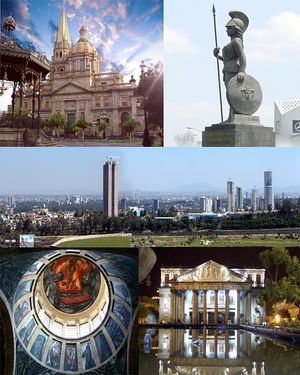 Guadalajara |
|
| 9 | Comarca Lagunera | Coahuila, Durango | 1,118,612 | 28 | Torreón | 609,509 | North | ||
| 10 | San Luis Potosí | San Luis Potosí | 1,036,555 | 19 | San Luis Potosí | 775,759 | Center-North | ||
| 11 | Querétaro | Querétaro | 1,036,154 | 17 | Querétaro | 790,416 | Center-North | ||
| 12 | Mérida | Yucatán | 954,813 | 12 | Mérida | 825,328 | South East | ||
| 13 | Mexicali | Baja California | 926,042 | 11 | Mexicali | 926,042 | North West | ||
| 14 | Aguascalientes | Aguascalientes | 906,758 | 18 | Aguascalientes | 776,495 | Center-North | ||
| 15 | Cuernavaca | Morelos | 850,405 | 51 | Cuernavaca | 362,300 | Center-South | Monterrey |
|
| 16 | Chihuahua | Chihuahua | 839,129 | 15 | Chihuahua | 812,490 | North West | ||
| 17 | Tampico | Tamaulipas, Veracruz | 834,983 | 60 | Tampico | 306,486 | North | ||
| 18 | Saltillo | Coahuila | 792,697 | 24 | Saltillo | 702,568 | North | ||
| 19 | Veracruz | Veracruz | 786,356 | 32 | Veracruz | 549,939 | East | ||
| 20 | Morelia | Michoacán | 782,890 | 21 | Morelia | 725,894 | West | ||
Immigration

Mexico is home to the largest number of U.S. citizens abroad (estimated at one million as of 1999),[193] which represents 1% of the Mexican population and 25% of all U.S. citizens abroad. Other significant communities of foreigners are those of Central and South America, most notably from Argentina, Brazil, Chile, Colombia, Peru, Cuba, Venezuela, Guatemala, and Belize. Though estimations vary, the Argentine community is considered to be the second largest foreign community in the country (estimated somewhere between 30,000 and 150,000).[194][195] Mexico also received a large number of Lebanese. The Mexican-Lebanese community now numbers around 400,000.[196]
Throughout the 20th century, Mexico followed a policy of granting asylum to fellow Latin Americans and Europeans (mostly Spaniards in the 1940s) fleeing political persecution in their home countries. In October 2008, Mexico tightened its immigration rules and agreed to deport Cubans using the country as an entry point to the US.[197] Because Mexico is much richer than the countries to its immediate southeast, it has a chronic problem with illegal immigration from those countries, especially Guatemala, Honduras, and El Salvador. Large numbers of Central American migrants who have crossed Guatemala's western border into Mexico are deported every year.[198]
Discrepancies between the figures for official legal aliens and those of all foreign-born residents regardless of their immigration status are quite large. The official figure for foreign-born legal residents in Mexico is 493,000 (since 2004), with a majority (86.9%) of these born in the United States (except Chiapas, where the majority of immigrants are from Central America). The five states with the most immigrants are Baja California (12.1% of total immigrants), Mexico City (the Federal District; 11.4%), Jalisco (9.9%), Chihuahua (9%) and Tamaulipas (7.3%). More than 54.6% of the immigrant population are fifteen years old or younger, while 9% are fifty or older.
Illegal immigration has been a problem for Mexico, especially since the 1970s. In 2006 Mexico detained more than 182,000 people who entered the country illegally, mainly from nearby Guatemala, Honduras, El Salvador, all being Central-American countries neighboring Mexico to the south. Smaller numbers of illegal immigrants come from Ecuador, Cuba, China, South Africa, and Pakistan. .[199]
Mexico represents the largest source of immigration to the United States. About 9% of the population born in Mexico is now living in the United States.[200] 28.3 million Americans listed their ancestry as Mexican as of 2006.[201]
Ethnic groups
Mexico is ethnically diverse, and the constitution defines the country to be a multicultural nation. Mexican nationality is relatively young, stemming back only to 1821 when Mexico achieved independence from the Spanish empire, and it consists of many, separate regional and ethnic groups such as the various indigenous peoples and European immigrants united under a single national identity.[202] The core part of Mexican national identity is formed on the basis of a synthesis of European culture with Indigenous cultures in a process known as mestizaje, alluding to the mixed biological origins of the majority of Mexicans. The term mestizo often used in literature about Mexican social identities carries a variety of meanings containing both socio-cultural, economic, racial and biological components and for this reason it has been deemed to imprecise to be used for ethnic classification, for which reason it has been abandoned in Mexican censuses.[203][204]
Genetic makeup
In 2004, the Mexican government founded the National Institute of Genomic Medicine (INMEGEN) which launched the Mexican Genome Diversity Project. In May 2009, the Institute issued a report on a major genomic study of the Mexican population. Among the findings, it was reported that of the 80% of the population that is mestizo, the proportions of European and indigenous ancestry are approximately even. The proportions of admixture were found to vary geographically from north to south, as previous pre-genomic studies had surmised, with the European contribution predominating in the north and the indigenous component greater in the south. One of the significant conclusions of the study as reported was that even while it is composed of diverse ancestral genetic groups from around the world, the Mexican population is genetically distinctive among the world's populations.[205]
Language
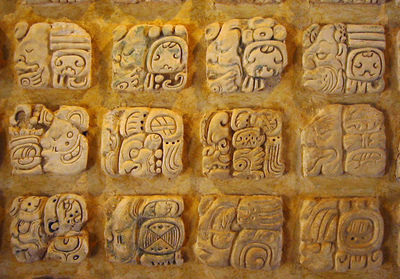
There is no de jure constitutional official language at the federal level in Mexico.[206] Spanish, spoken by 97% of the population, is considered a national language by The General Law of Linguistic Rights of the Indigenous Peoples, which also grants all indigenous minority languages spoken in Mexico, regardless of the number of speakers, the same validity as Spanish in all territories in which they are spoken, and indigenous peoples are entitled to receive public services and documents in their native languages.[207]
Mexican law has granted these indigenous minority languages the status of "national languages", along with Spanish. The law includes all Amerindian languages regardless of origin; that is, it includes the Amerindian languages of ethnic groups non-native to the territory. As such the National Commission for the Development of Indigenous Peoples recognizes the language of the Kickapoo, which immigrated from the United States,[208] and recognizes the languages of the Guatemalan Amerindian refugees.[209] The Mexican government has promoted and established intercultural bilingual primary and secondary education in some indigenous rural communities. Approximately 5.4% of the population speaks an indigenous language and 1.2% do not speak Spanish.[210] The indigenous language groups with the most speakers are Nahuatl languages, Yukatek Maya, Mixtecan languages, Zapotec languages, Tzeltal, and Otomi.[211]
Mexico has the largest Spanish-speaking population in the world with more than twice as many as the second largest Spanish-speaking country. (Spain, Argentina, and Colombia all have about 40 million speakers each.) Almost a third of all Spanish native speakers in the world live in Mexico.[187] Nahuatl is spoken by 1.5 million people and Yucatec Maya by 800,000. Some of the national languages are in danger of extinction; Lacandon is spoken by fewer than one hundred people.
English is widely used in business at the border cities, as well as by the one million U.S. citizens that live in Mexico, mostly retirees in small towns in Baja California, Guanajuato and Chiapas.[193] There are some 80,000 German-speaking Mennonites in Mexico.[212]
Religion
Mexico has no official religion, and the government does not provide any financial contributions to the church, and the church does not participate in public education.
The last census reported, by self-ascription, that at least 82.8% of the population is Christian. Roman Catholics are 76.5%[213] of the total population, 47% percent of whom attend church services weekly.[214] In absolute terms, Mexico has the world's second largest number of Catholics after Brazil.[215]
About 6.3% of the population is Protestant,[213] of whom Pentecostals (1.4%) are the largest group.[213] There are also a sizeable number of Seventh-day Adventists (0.6 million people).[216] The Jehovah's Witnesses are 1.1% of the country's population.[213] The Church of Jesus Christ of Latter-day Saints claims over one million registered members as of 2009.[217] About 25% of registered members attend a weekly sacrament service although this can fluctuate up and down.[218] There are eleven Temples of the Church of Jesus Christ of Latter-day Saints in Mexico.
The presence of Jews in Mexico dates back to 1521, when Hernán Cortés conquered the Aztecs, accompanied by several Conversos. There are now more than 45,000 Mexican Jews. 3.1% of the population reported having no religion.[213] Islam in Mexico is practiced by a small population in the city of Torreón, Coahuila, and there are an estimated 300 Muslims in the San Cristóbal de las Casas area in Chiapas.[219][220] Mexico's Buddhist population currently makes up a tiny minority, some 108,000 according to latest accounts. Most of its members are of Asian descent, while people of various other walks of life have turned toward Buddhism in the recent past.
In 1992, Mexico lifted almost all restrictions on the Catholic Church and other religions, including granting all religious groups legal status, conceding them limited property rights, and lifting restrictions on the number of priests in the country.[221] Until recently, priests did not have the right to vote, and even now they cannot be elected to public office.
Culture
Mexican culture reflects the complexity of the country's history through the blending of pre-Hispanic civilizations and the culture of Spain, imparted during Spain's 300-year colonization of Mexico. Exogenous cultural elements mainly from the United States have been incorporated into Mexican culture.
The Porfirian era (el Porfiriato), in the last quarter of the nineteenth century and the first decade of the twentieth century, was marked by economic progress and peace. After four decades of civil unrest and war, Mexico saw the development of philosophy and the arts, promoted by President Díaz himself. Since that time, as accentuated during the Mexican Revolution, cultural identity has had its foundation in the mestizaje, of which the indigenous (i.e. Amerindian) element is the core. In light of the various ethnicities that formed the Mexican people, José Vasconcelos in his publication La Raza Cósmica (The Cosmic Race) (1925) defined Mexico to be the melting pot of all races (thus extending the definition of the mestizo) not only biologically but culturally as well.[222] This exalting of mestizaje was a revolutionary idea that sharply contrasted with the idea of a superior pure race prevalent in Europe at the time.
Architecture

In a broad sense, Mexican architecture comprises works of architecture created in Mexico, as well as architecture of pre-Hispanic and colonial times that have become part of Mexico's architectural heritage. Moreover, architectural styles of the independent nation have a strong influence from those previous epochs; therefore it is necessary to include them as part of this heritage. Mesoamerican architecture is the set of architectural traditions produced by pre-Columbian cultures and civilizations of Mesoamerica, traditions which are best known in the form of public, ceremonial and urban monumental buildings and structures. The distinctive features of Mesoamerican architecture encompass a number of different regional and historical styles, which however are significantly interrelated. These styles developed throughout the different phases of Mesoamerican history as a result of the intensive cultural exchange between the different cultures of the Mesoamerican culture area through thousands of years. Mesoamerican architecture is mostly noted for its pyramids which are the largest such structures outside of Ancient Egypt.
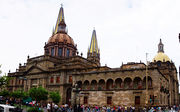
Spanish Colonial architecture, which dominated in the early Spanish colonies, is marked by the contrast between the simple, solid construction demanded by the new environment and the Baroque ornamentation exported from Spain. Mexico, as the center of New Spain has some of the most renowned buildings built in this style. With twenty-nine sites, Mexico has more sites on the UNESCO World Heritage list than any other country in the Americas, many of them boasting some of the richest Spanish Colonial architecture. Some of the most famous cities in Mexico built in the Colonial style are Puebla, Zacatecas, Querétaro, Guanajuato, and Morelia.
During President Porfirio Diaz's reign (1876–1880, 1884–1911), patrons and practitioners of architecture manifested two impulses: to create an architecture that would indicate Mexico's participation in modernity and the emphasize Mexico's difference from other countries through the incorporation of local characteristics into the architecture. The first goal took precedence over the second during most of the nineteenth century. A modern, sophisticated Mexico was the goal of President Diaz. Cast iron, marble, granite, bronzes and stained glass became mainstays of this period. Diaz was determined to transform the landscape of the nation's capital into one reminiscent of Paris or London. It is not surprising that the most important architectural commissions of the Porfiriato were built in these styles.

Examples include the Postal Palace, the National Theatre of Mexico (1904), the Legislative Palace (1903), the Secretariat of Communications and Public Works (1902–11). Neo-Gothic designs were also incorporated into the monumental public buildings of the early twentieth century. The two best examples were the Central post office and the Palacio de Bellas Artes.
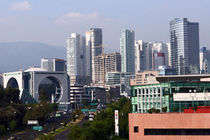
After the Mexican Revolution in 1917, idealization of the indigenous and the traditional symbolized attempts to reach into the past and retrieve what had been lost in the race toward modernization. The School of Theatre (1994), by TEN Arquitectos, and the School of Dance (1994), by Luis Vicente Flores, express a modernity that reinforces the government's desire to present a new image of Mexico as an industrialized country with a global presence. Enrique Norten, the founder of TEN Arquitectors, was presented with the "Legacy Award" by the Smithsonian Institution for his contributions to the US arts and culture through his work. In 2005 he received the "Leonardo da Vinci" World Award of Arts by the World Cultural Council and was the first Mies van der Rohe Award recipient for Latin American Architecture.
The José Vasconcelos Library, designed by Alberto Kalach, in Mexico City The refined work of Alberto Kalach and Daniel Alvarez stands out both in their numerous residences as well as in the San Juan de Letrán Station (1994) in Mexico City. The residential work of José Antonio Aldrete-Haas in Mexico City shows both the influence of the attenuated Modernism of the great Portuguese architect Álvaro Siza and a continuity with the lessons of Barragán. Other notable and emerging contemporary architects include Mario Schjetnan, Michel Rojkind, Tatiana Bilbao, Isaac Broid and Bernardo Gómez-Pimienta, Juan C. Ordaz Coppel and Jacinto Avalos from Avalos Arquitectos y Asociados with award winning works in Mexico, USA and Europe. Modern buildings (especially skyscrapers) in Mexico share many design parallels with modern urban Japanese, Chinese and German architecture however modern Mexican architecture usually integrates elements of both Hispanic and amerindian architectural styles.
Cinema

Mexican films from the Golden Age in the 1940s and 1950s are the greatest examples of Latin American cinema, with a huge industry comparable to the Hollywood of those years. Mexican films were exported and exhibited in all of Latin America and Europe. Maria Candelaria (1944) by Emilio Fernández, was one of the first films awarded a Palme d'Or at the Cannes Film Festival in 1946, the first time the event was held after World War II. The famous Spanish-born director Luis Buñuel realized in Mexico, between 1947 to 1965 some of him master pieces like Los olvidados (1949), Viridiana (1961) and El angel exterminador (1963). Famous actors and actresses from this period include María Félix, Pedro Infante, Dolores del Río, Jorge Negrete and the comedian Cantinflas.
More recently, films such as Como agua para chocolate (1992), Cronos (1993), Amores perros (2000), Y tu mamá también (2001), El Crimen del Padre Amaro (2002), Pan's Labyrinth (2006) and Babel (2006) have been successful in creating universal stories about contemporary subjects, and were internationally recognised, as in the prestigious Cannes Film Festival. Mexican directors Alejandro González Iñárritu (Amores perros, Babel), Alfonso Cuarón (Children of Men, Harry Potter and the Prisoner of Azkaban), Guillermo del Toro, Carlos Carrera (The Crime of Father Amaro), and screenwriter Guillermo Arriaga are some of the most known present-day film makers.
Music

Mexican society enjoys a vast array of music genres, showing the diversity of Mexican culture. Traditional music includes Mariachi, Banda, Norteño, Ranchera and Corridos; on an every-day basis most Mexicans listen to contemporary music such as pop, rock, etc. in both English and Spanish. Mexico has the largest media industry in Latin America, producing Mexican artists who are famous in Central and South America and parts of Europe, especially Spain. Some well-known Mexican singers are Thalía, Luis Miguel, Alejandro Fernández, Julieta Venegas and Paulina Rubio. Mexican singers of traditional music are: Lila Downs, Susana Harp, Jaramar, GEO Meneses and Alejandra Robles. Popular groups are Café Tacuba, Molotov and Maná, among others.

According to the Sistema Nacional de Fomento Musical, there are between 120 and 140 youth orchestras affiliated to this federal agency from all federal states. Some states, through their state agencies in charge of culture and the arts—Ministry or Secretariat or Institute or Council of Culture, in some cases Secretariat of Education or the State University—sponsor the activities of a professional Symphony Orchestra or Philharmonic Orchestra so all citizens can have access to this artistic expression from the field of classical music. There is no public information about the exact number of professional orchestras in the country (probably 40 ensembles of very diverse caliber). Mexico City is the most intense hub of this activity hosting 12 professional orchestras sponsored by different agencies such as the National Intitute of Fine Arts, the Secretariat of Culture of the Federal District, The National University, the National Polytechnic Institute, a Delegación Política (Coyoacán) and very few are a kind of private ventures.
Orquestas in Mexico are mainly subsidized by a governmental body or agency, unlike their American counterparts, therefore, these organizations do not have departments such as marketing or development. States such as Baja California Sur, Campeche, Chiapas, Colima, Morelos, Nayarit, Quintana Roo, Sonora, Tabasco, and Tlaxcala do not have a professional Symphony orchestra. The only permanent opera company belongs to the National Institute of Fine Arts, offering six productions yearly, however, some cities such as Guadalajara, Monterrey or Morelia make important efforts to present this kind of expression to local audiences.
Since the early 2000s Mexican rock has seen widespread growth both domesticly and internationally. Mexico is home to many alternative, hardcore, heavy metal, gothic metal, Industrial, Electro-industrial, emo, screamo, death metal, deathcore, metalcore and thrash metal bands, some of the most known of which are Transmetal, MG-42, PCN, PXNDX, Chasm , Shenovah, Asesino, Senda de Honor, Anabantha, Hialiana, Hocico, The last divine massacre, Distructura, and Insite. Other bands such as, Division Minuscula, Delux, Here Comes the Kraken and Thermo have gained international attention becoming popular in foreign areas such as the United States, Japan, South Korea, Europe and latin america. Mexican rock, particularly screamo, death metal, deathcore, metalcore and thrash metal bands have become especially popular in Germany and Russia. Many Mexican rock bands have lyrics in Spanish and English with many also occasionally singing in German or amerindian languages such as Zapotec languages or Nahuatl. There are also large underground rock groups in virtually every part of the country which have become extremely popular with teenagers and young adults throughout all classes and segments of society.
National holidays

Mexicans celebrate their independence from Spain on September 16, and other holidays with colorful festivals known as "Fiestas". Every Mexican city, town and village holds a yearly festival to commemorate their local patron saints. During these festivities, the people pray and burn candles to honor their saints in churches decorated with flowers and colorful utensils. They also hold large parades, fireworks, dance competitions, beauty pageant contest, party and buy refreshments in the market places and public squares. In the smaller towns and villages, soccer, boxing, cockfighting and amateur bullfighting are also celebrated during the festivities.
Other festivities include Día de Nuestra Señora de Guadalupe ("Guadalupe Day"), Las Posadas ("The Shelters", celebrated on December 16 to December 24), Noche Buena ("Holy Night", celebrated on December 24), Navidad ("Christmas", celebrated on December 25) and Año Nuevo ("New Years Day", celebrated on December 31 to January 1). "Guadalupe Day" is regarded by many Mexicans as the most important religious holiday of their country. It honours the Virgin of Guadalupe, the patron saint of Mexico, which is celebrated on December 12. In the last decade, all the celebrations happening from mid December to the beginning of January have been linked together in what has been called the Guadalupe-Reyes Marathon.
Piñatas are unique to Mexican celebrations. A pinata is made from papier-mache. It is created to look like popular people, animals, or fictional characters. Once made it is painted with bright colors and filled with candy or small toys. It is then hung from the ceiling. The children are blind folded and take turns hitting the piñata until it breaks open and the candy and small toys fall out. The children then gather the candy and small toys.
Fine arts
.jpg)
Post-revolutionary art in Mexico had its expression in the works of renowned artists such as Frida Kahlo, Diego Rivera, José Clemente Orozco, Rufino Tamayo, Federico Cantú Garza, David Alfaro Siqueiros and Juan O'Gorman. Diego Rivera, the most well-known figure of Mexican Muralism, painted the Man at the Crossroads at the Rockefeller Center in New York City, a huge mural that was destroyed the next year due to the inclusion of a portrait of Russian communist leader Lenin.[223] Some of Rivera's murals are displayed at the Mexican National Palace and the Palace of Fine Arts.
Academic music composers of Mexico include Manuel María Ponce, José Pablo Moncayo, Julián Carrillo, Mario Lavista, Carlos Chávez, Silvestre Revueltas, Arturo Márquez, and Juventino Rosas, many of whom incorporated traditional elements into their music. Nobel Prize winner Octavio Paz, Carlos Fuentes, Juan Rulfo, Elena Poniatowska, and José Emilio Pacheco, are some of the most recognized Mexican authors.
Literature

The literature of Mexico has its antecedents in the literatures of the indigenous settlements of Mesoamerica. The most well known prehispanic poet is Netzahualcoyotl. Modern Mexican literature was influenced by the concepts of the Spanish colonialization of Mesoamerica. Outstanding colonial writers and poets include Juan Ruiz de Alarcón and Sor Juana Inés de la Cruz.
Other writers include Alfonso Reyes, José Joaquín Fernández de Lizardi, Ignacio Manuel Altamirano, Carlos Fuentes, Octavio Paz (Nobel Laureate), Renato Leduc, Jaime Labastida, Mariano Azuela ("Los de abajo") and Juan Rulfo ("Pedro Páramo"). Bruno Traven wrote "Canasta de cuentos mexicanos", "El tesoro de la Sierra Madre."
Broadcast media
Two of the major television networks based in Mexico are Televisa and TV Azteca. Televisa is also the largest producer of Spanish-language content in the world and also the world's largest Spanish-language media network.[224] Grupo Multimedios is another media conglomerate with Spanish-language broadcasting in Mexico, Spain, and the United States. Soap operas (telenovelas) are translated to many languages and seen all over the world with renowned names like Verónica Castro, Lucía Méndez, Lucero, and Thalía. Even Gael García Bernal and Diego Luna from Y tu mamá también and current Zegna model have appeared in some of them.
Some of their TV shows are modeled after counterparts from the U.S. like Family Feud (100 Mexicanos Dijeron or "A hundred Mexicans said" in Spanish) and ¿Qué dice la gente?, Big Brother, American Idol, Saturday Night Live and others. Nationwide news shows like Las Noticias por Adela on Televisa resemble a hybrid between Donahue and Nightline. Local news shows are modeled after counterparts from the U.S. like the Eyewitness News and Action News formats. Border cities receive television and radio stations from the U.S., while satellite and cable subscription is common for the middle-classes in most cities, and they often watch movies and TV shows from the U.S.
Cuisine
Mexican cuisine is known for its intense and varied flavors, colorful decoration, and variety of spices. Most of today's Mexican food is based on pre-Columbian traditions, including the Aztecs and Maya, combined with culinary trends introduced by Spanish colonists.
The conquistadores eventually combined their imported diet of rice, beef, pork, chicken, wine, garlic and onions with the native pre-Columbian food, including maize, tomato, vanilla, avocado, papaya, pineapple, chili pepper, beans, squash, limes (limón in Mexican Spanish), sweet potato, peanut and turkey.
Mexican food varies by region, because of local climate and geography and ethnic differences among the indigenous inhabitants and because these different populations were influenced by the Spaniards in varying degrees. The north of Mexico is known for its beef, goat and ostrich production and meat dishes, in particular the well-known Arrachera cut.
Central Mexico's cuisine is largely made up of influences from the rest of the country, but also has its authentics, such as barbacoa, pozole, menudo, tamales, and carnitas.
Southeastern Mexico, on the other hand, is known for its spicy vegetable and chicken-based dishes. The cuisine of Southeastern Mexico also has quite a bit of Caribbean influence, given its geographical location. Seafood is commonly prepared in the states that border the Pacific Ocean or the Gulf of Mexico, the latter having a famous reputation for its fish dishes, à la veracruzana.
In modern times, other cuisines of the world have become very popular in Mexico, thus adopting a Mexican fusion. For example, sushi in Mexico is often made with a variety of sauces based on mango or tamarind, and very often served with serrano-chili-blended soy sauce, or complemented with vinegar, habanero and chipotle peppers
The most internationally recognized dishes include chocolate, tacos, quesadillas, enchiladas, burritos, tamales and mole among others. Regional dishes include mole poblano, chiles en nogada and chalupas from Puebla; cabrito and machaca from Monterrey, cochinita pibil from Yucatán, Tlayudas from Oaxaca, as well as barbacoa, chilaquiles, milanesas, and many others.
Sports


Mexico City hosted the XIX Olympic Games in 1968, making it the first Latin American city to do so (Rio de Janeiro will be the second in 2016).[225] The country has also hosted the FIFA World Cup twice, in 1970 and 1986.[226]
Mexico's most popular sport is association football (soccer). It is commonly believed that Football was introduced in Mexico by Cornish miners at the end of the 19th century. By 1902 a five-team league had emerged with a strong English influence.[227][228] Football became a professional sport in 1943. Since the "Era Professional" started, Mexico's top clubs have been Guadalajara with 11 championships, América with 10 and Toluca with 9.[229] In Mexican Football many players have been raised to the level of legend, but two of them have received international recognition above others. Antonio Carbajal was the first player to appear in five World Cups, and Hugo Sánchez was named best CONCACAF player of the 20th century by IFFHS. Mexican's biggest stadiums are Estadio Azteca, Estadio Olímpico Universitario and Jalisco Stadium. Notable achievements by Mexican national soccer teams include winning the 1999 Confederations Cup, the 2005 U-17 World Cup, and being runners-up in the 1977 U-20 World Cup, 1993 Copa America, and 2001 Copa America. The Mexican team was also a runner-up in the 2007 Beach Soccer World Cup. Mexican football clubs have achieved good results in international competitions like the Copa Libertadores and the FIFA Club World Championship.
The national sport of Mexico is Charreada.[230] Bullfighting is also a popular sport in the country, and almost all large cities have bullrings. Plaza México in Mexico City, is the largest bullring in the world, which seats 55,000 people. Professional wrestling (or Lucha libre in Spanish) is a major crowd draw with national promotions such as AAA, LLL, CMLL and others.
Baseball is very popular, especially in the Gulf of Mexico, Yucatán Peninsula and the Northern States. In some regions baseball has traditionally been more popular than soccer. The season runs from March to July with playoffs held in August. The Mexican professional league is named the Liga Mexicana de Beisbol. Current champions (2007) are Sultanes de Monterrey who defeated in a tight series Leones de Yucatán. However, the best level of baseball is played in Liga Mexicana del Pacífico, played in Sinaloa, Sonora and Baja California. Given that it is played during the MLB off-season, some of its players are signed to play with the league 8 teams. Current champions (2007) are Yaquis de Obregon. The league champion participates in the Caribbean Series, a tournament between the Champions of Winter Leagues of Mexico, Venezuela, Puerto Rico and the Dominican Republic; the 2009 Caribbean Series edition will be held in Mexicali. While usually not as strong as the United States, the Caribbean countries and Japan, Mexico has nonetheless achieved several international baseball titles. Mexico has had several players signed by Major League teams, the most famous of them being Dodgers pitcher Fernando Valenzuela.
Mexican clubs (such as Monterrey La Raza) participate in North American indoor soccer leagues. Mexico is also a leading country in Basque Pelota. Tennis has also traditionally been popular in Mexico, having produced some great players like Rafael Osuna, though international successes have been very few in recent years.
Mexico is an international power in professional boxing (at the amateur level, several Olympic boxing medals have also been won by Mexico). Vicente Saldivar, Rubén Olivares, Salvador Sánchez, Julio César Chávez, Ricardo Lopez and Erik Morales are but a few Mexican fighters who have been ranked among the best of all time.
The most important professional basketball league is the Liga Nacional de Baloncesto Profesional and covers the whole Mexican territory, where the Soles de Mexicali are the current champions. In 2007 three Mexican teams will be competing in the American Basketball Association. In the northwestern states is the CIBACOPA Competition, with professional basketball players from Mexico and the U.S. Universities and some teams from the NBA.
Mexico is a major international power in Taekwondo. Mexican athletes have achieved renown in disciplines like marathon running, racewalking and diving.
American football is played at the major universities like ITESM, UANL, UDLA, IPN and UNAM. The college league in Mexico is called ONEFA. Several Mexican players have been signed by the NFL over the years. Rugby is played at the amateur level throughout the country with the majority of clubs in Mexico City and others in Monterrey, Guadalajara, Celaya, Guanajuato and Oaxaca.
Auto racing is very popular in Mexico. Throughout the years, Mexico has hosted races for some of the most important international championships such as Formula One, NASCAR, Champ Car, A1 Grand Prix, among others. Mexico also has its own NASCAR-sanctioned stock car series, the NASCAR Mexico, which runs 14 events in different cities, drawing large crowds. Other forms of racing include Formula Renault, Formula Vee, touring cars, Pick-up trucks, endurance racing, rallying, and off-road.
Ice hockey is played in larger cities like Monterrey, Guadalajara, Villahermosa, Culiacán and Mexico City.
Notable Mexican athletes include golfer Lorena Ochoa, who is currently ranked first in the LPGA world rankings,[231] Ana Guevara, former world champion of the 400 metres (1,300 ft) and Olympic subchampion in Athens 2004, and Fernando Platas, a numerous Olympic medal winning diver.
Sport fishing is popular in Baja California and the big Pacific coast resorts, while freshwater bass fishing is growing in popularity too. The gentler arts of diving and snorkeling are big around the Caribbean, with famous dive sites at Cozumel and on the reefs further south. The Pacific coast is becoming something of a center for surfing, with few facilities as yet; all these sports attract tourists to Mexico.
Another sport in which Mexico is competitive at the international level is polo.
Healthcare and education
- Main articles: Health care in Mexico and Education in Mexico. See also 2009 swine flu outbreak.


Since the early 1990s, Mexico entered a transitional stage in the health of its population and some indicators such as mortality patterns are identical to those found in highly developed countries like Germany or Japan.[232] Although all Mexicans are entitled to receive medical care by the state, 50.3 million Mexicans had no medical insurance as of 2002.[233] Efforts to increase the number of people are being made, and the current administration intends to achieve universal health care by 2011.[234][235]
Mexico's medical infrastructure is highly rated for the most part and is usually excellent in major cities,[236][237] but rural areas and indigenous communities still lack equipment for advanced medical procedures, forcing patients in those locations to travel to the closest urban areas to get specialized medical care.[238]
State-funded institutions such as Mexican Social Security Institute (IMSS) and the Institute for Social Security and Services for State Workers (ISSSTE) play a major role in health and social security. Private health services are also very important and account for 13% of all medical units in the country.[239]
| Educational oversight
Minister of Public Education
|
Secretariat of Public Education Josefina Vázquez Mota |
| National education budget (2007) | MXN$1,309,691,048,383 USD$148,342,469,250 |
| Primary language(s) of education | Spanish as the standard. Other minority languages are also available in their local communities. |
| Nationalized system Establishment |
25 September 1921 |
| Literacy (2006) • Men • Women |
97.7 % 98.4% 96.8 % |
| Enrollment • Primary • Secondary • Post-secondary |
61.6 million 26.4 million 19.8 million 15.3 million |
| Attainment • Secondary diploma • Post-secondary diploma |
N/A N/A |
| Sources: Sistema Educativo de los Estados Unidos Mexicanos. Principales cifras, ciclo escolar 2003-2004 pdf and the 2000 Census (INEGI) | |
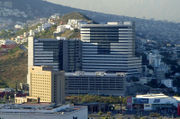
Medical training is done mostly at public universities with much specializations done in vocational or internship settings. Some public universities in Mexico, such as the University of Guadalajara, have signed agreements with the U.S. to receive and train American students in Medicine. Health care costs in private institutions and prescription drugs in Mexico are on average lower than that of its North American economic partners.[236]
Education in Mexico is highly competitive and actively pursued especially in Amerindian communities as it as seen as the primary path to success and employment. Mexico has one of the highest student-to-teaching staff ratio in the world with 26 students per teacher nationwide, when all levels from pre-K through post secondary education are included.[240] According to the OCED, compared to students from the worlds thirty most developed nations, Mexican students came in fourth in problem solving, third in science and technology and eighth in mathematics.[241] Mexico has one of the largest educational budgets in the world meausured by actual spending and as a percentage of GDP. In 2009 the educational budget was $148 billion equalling 9.7% of total GDP. In 2004, the literacy rate was at 97%[242] for youth under the age of 14 and 91% for people over 15,[243] placing Mexico at the 24th place in the world rank accordingly to UNESCO.[244] Primary and secondary education (9 years) is free and mandatory. Even though different bilingual education programs have existed since the 1960s for the indigenous communities, after a constitutional reform in the late 1990s, these programs have had a new thrust, and free text books, software, and vocational programs are available in more than a dozen indigenous languages.

In the 1970s, Mexico established a system of "distance-learning" through satellite communications to reach otherwise inaccessible small rural and indigenous communities. Schools that use this system are known as telesecundarias in Mexico. The Mexican distance learning secondary education is also transmitted to some Central American countries and to Colombia, and it is used in some southern regions of the United States as a method of bilingual education. There are approximately 30,000 telesecundarias and approximately a million telesecundaria students in the country.[245]
The largest and most prestigious public university in Mexico, today numbering over 269,000 students, is the National Autonomous University of Mexico (Universidad Nacional Autónoma de México, UNAM) founded in 1910. Three Nobel laureates and most of Mexico's modern-day presidents are among its former students. UNAM conducts an astounding 50% of Mexico's scientific research and has presence all across the country with satellite campuses and research centers. The National Autonomous University of Mexico ranks 15th place in the Top 200 World University Ranking published by The Times Higher Education Supplement in 2008,[246] making it the highest ranked Spanish-speaking university in the world and the highest ranked in Latin America. The second largest university is the National Polytechnic Institute (IPN). These institutions are public, and there are at least a couple of public universities per state.
One of the most prestigious private universities is Monterrey Institute of Technology and Higher Education (ITESM). It was ranked by the Wall Street Journal as the 7th top International Business School worldwide[247] and 74th among the world's top arts and humanities universities ranking of The Times Higher Education Supplement, published in 2005. ITESM has thirty-two secondary campuses, apart from its Monterrey Campus. Other important private universities include Mexico's Autonomous Technological Institute (ITAM), ranked as the best economics school in Latin America, Fundación Universidad de las Américas, Puebla (UDLAP) and the Ibero-American University (Universidad Iberoamericana).
In April 2009 Mexico saw the outbreak of a new strain of H1N1 influenza, which has infected up to 800 people and infected over 140,000 worldwide as of July 20.
Science and technology


After the Viceroyalty of New Spain was founded, the Spanish brought the scientific culture that dominated Spain to the Viceroyalty of New Spain.[248] The municipal government (cabildo) of Mexico City formally requested the Spanish crown to establish a university in 1539.[249] The Royal and Pontifical University of Mexico (Real y Pontificia Universidad de México) was established in 1551. The university was administered by the clergy and it was the official university of the empire. It provided quality education for the people, and it was a hub of intellectual and religious development in the region. It taught subjects such as physics and mathematics from the perspective of Aristotelian philosophy. Augustinian philosopher Alonso Gutiérrez wrote Physica speculatio, America's first scientific text, in 1557. By the late eighteenth century, the university had trained 1,162 doctors, 29,882 bachelors, and many lawyers.[248]
During the Mexican Enlightenment, science can be divided into the four period: the early period (from 1735 to 1767), the creole period (from 1768 to 1788), the official or Spanish period (from 1789 to 1803), and the period of synthesis (from 1804 to the beginning of the Mexico's independence movement in 1810).[250]
During the sixteenth and seventeenth centuries, modern science developed in Europe, but it lagged behind in Mexico. The new ideas developed in science in Europe were not important in Mexico.[251] The 1767 expulsion of Jesuits, who had introduced the new ideas in Mexico, helped to antagonize the creoles, and also promoted nation feelings among Mexicans.[250][252]
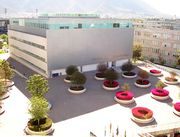
After the expulsion, self-taught upper class civilians were the first scientists in Mexico. Later on, they were joined by the Spanish scientists, and they did research, teaching, publishing, and translating texts. The ideas of Francis Bacon and René Descartes were freely discussed at seminars, which caused scholasticism to lose strength. During the Mexican Enlightenment, Mexico made progress in science. Progress were made in subjects such as astronomy, engineering, etc. In 1792 the Seminary of Mining was established. Later it became College of Mining, in which the first modern physics laboratory in Mexico was established.[250]
Famous scientists of the Enlightenment included José Antonio de Alzate y Ramírez and Andrés Manuel del Río.[250] Río discovered the chemical element vanadium in 1801.[253]
The Mexican War of Independence brought temporary end to Mexico's scientific progress. The Royal and Pontifical University of Mexico closed in 1833. For many years, there were no scientific activities in Mexico.[250] The Royal and Pontifical University of Mexico was definitively shut down in 1865.[254]
During the end of the nineteenth century, the process of industrialization began in Mexico. Under the influence of positivists and scientific thinkers, the government assisted in public education. In 1867 Gabino Barreda, a student of Auguste Comte, was charged with the commission aimed at reforming education. Subjects such as physics, chemistry, and mathematics were included into the secondary school curriculum. National Preparatory School was established. The influence of positivists led to a renaissance of scientific activity in Mexico.[255] General Manuel Mondragon, invented the first automatic rifle the Mondragón rifle during this time.
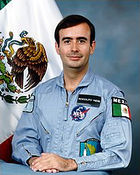

During the twentieth century, Mexico made significant progress in science and technology. New universities and research institutes were established. The National Autonomous University of Mexico (Universidad Nacional Autónoma de México, UNAM) was officially established in 1910,[256] and the university become one of the most important institutes of higher learning in Mexico.[254] UNAM provides world class education in science, medicine, and engineering.[257] Many scientific institutes and new institutes of higher learning, such as National Polytechnic Institute (founded in 1936),[258] were established during the first half of the twentieth century. Most of the new research institutes were created within UNAM. Twelve institutes were integrated into UNAM from 1929 to 1973.[259]
In 1959, the Mexican Academy of Sciences (Academia Mexicana de Ciencias) was established as a non-governmental, non-profit organization of distinguished scientists. The Academy has grown in membership and influence, and it represents a strong voice of scientists from different fields, mainly in science policy.[260]
By 1960, science was institutionalized in Mexico. It was viewed as a legitimate endeavor by the Mexican society.[259]
In 1960, the Center for Research and Advanced Studies of the National Polytechnic Institute was established as a center for graduate studies in subjects such as biology, mathematics, and physics. In 1961, the institute began its graduate programs in physics and mathematics and schools of science were established in Mexican states of Puebla, San Luis Potosí, Monterrey, Veracruz, and Michoacán. The Academy for Scientific Research was established in 1969 and the National Council of Science and Technology was established in 1971.[259]
In 1985 Rodolfo Neri Vela became the first Mexican citizen to enter space as part of the STS-61-B mission.[261]

In 1995 Mexican chemist Mario J. Molina shared the Nobel Prize in Chemistry with Paul J. Crutzen, and F. Sherwood Rowland for their work in atmospheric chemistry, particularly concerning the formation and decomposition of ozone.[262] Molina, an alumnus of UNAM, became the first Mexican citizen to win the Nobel Prize in science.[263]
In recent years, the biggest scientific project being developed in Mexico was the construction of the Large Millimeter Telescope (Gran Telescopio Milimétrico, GMT), the world's largest and most sensitive single-aperture telescope in its frequency range.[264] It was designed to observe regions of space obscured by stellar dust.
In 1962, the National Commission of Outer Space (Comisión Nacional del Espacio Exterior, CONNE) was established, but was dismantled in 1977. In 2007, a project was presented to re-open a new Mexican Space Agency (AEXA) and it was approved at the end of 2008 with the headquarters set to be located in the state of Hidalgo.

Government institutions such as SEMAR and SEDENA have also developed advanced microprocessors, imaging systems, military A.I. systems, rockets, software, long range ballistic missiles,[112] electronic devices and electronic military subsystems many of which have been sold to other Latin American nations. Other consumer electronics companies such as Mabe have been functioning since the nineteen fifties and have expanded out of Latin America into markets around the world such as Asia and Europe and even into the United States where a large percentage of American branded appliances are actually of Mexican design and origin but sold under local brand names.[265][266] In fact as of 2008 one out of every four consumer appliances sold in the United States was of Mexican origin.[267] According to the World Bank, production of high-technology good represented 22% of Mexico's GDP in 2000 with the high tech sector gorwing by roughly 63% yearly.[268] Since the 1990s Mexico has produced advanced automobiles for foreign companies (mainly BMW and Mercedes-Benz), and for domestic coroporations such as Mastretta.
Robotics are also a growing area of development in Mexico. The Mexone robot and robotics built by the Panteras robotics organization have sparked popular interest in robotics. In 2009 Kuka-Xiuhcoatl, Mexico's subsidiary of German robotics conglomerate Kuka Gesellschaft mit beschränkter Haftung surpased it's parent in both sales and units produced with an increasing number of the components and entire robots being designed by the Mexican branch itself at Kuka-Xiuhcoatl's Guadalajara facility.
Based on the information managed by the Scopus, a bibliographic database for science, the Spanish web portal SCImago places Mexico in the position 18 of the country scientific ranking with 82,792 publications, and in the position 34 if considering its value of 134 for the h-index. Both positions are computed for the period 1996-2
International rankings
| Organization | Survey | Ranking |
|---|---|---|
| Institute for Economics and Peace [4] | Global Peace Index[269] | 108 out of 144 |
| United Nations Development Programme | Human Development Index | 53 out of 182 |
| Transparency International | Corruption Perceptions Index | 89 out of 180 |
| World Economic Forum | Global Competitiveness Report | 60 out of 133 |
See also
- Federal government of Mexico
- Politics of Mexico
- State governments of Mexico
References
- ↑ 1.0 1.1 "Presidency of Mexico – Official Name of the Country". Presidencia.gob.mx. 2005-03-31. http://www.presidencia.gob.mx/index.php?DNA=91. Retrieved 2010-05-30.
- ↑ CIA World Fact Book. See Country Name-Local Long Form under Government. Retrieved February 22, 2010.
- ↑ However, the General Law of Linguistic Rights for the Indigenous Peoples recognizes all Amerindian minority languages, along with Spanish, as national languages and equally valid in territories where spoken. The government recognizes 62 indigenous languages, and more variants which are mutually unintelligible.Comisión Nacional para el Desarrollo de los Pueblos Indígenas. CDI. México
- ↑ "Political Constitution of the United Mexican States Title 2 Article 40". SCJN. http://www.scjn.gob.mx/SiteCollectionDocuments/PortalSCJN/RecJur/BibliotecaDigitalSCJN/PublicacionesSupremaCorte/Political_constitucion_of_the_united_Mexican_states_2008.pdf. Retrieved 2010-08-14.
- ↑ "CIA – The World Factbook – Mexico". Cia.gov. https://www.cia.gov/library/publications/the-world-factbook/geos/mx.html. Retrieved 2009-11-04.
- ↑ 6.0 6.1 6.2 6.3 "World Bank data". http://ddp-ext.worldbank.org/ext/DDPQQ/member.do?method=getMembers&userid=1&queryId=135.
- ↑ Human Development Report 2007/2008
- ↑ Human Development Report 2009. The United Nations. Retrieved 5 October 2009.
- ↑ The alternative translation Mexican United States was used in a book published in 1824. That is, almost 200 years ago, and exactly 3 years after its independence was internationally recognized. The Federal Constitution of the Mexican United States.
- ↑ Merriam-Webster's Geographical Dictionary, 3rd ed. Springfield, MA: Merriam-Webster, Inc.; p. 733
- ↑ "Mexico". The Columbia Encyclopedia, 6th ed. 2001–6. New York: Columbia University Press.
- ↑ "Mexico — Geography". CIA The World Factbook. CIA. https://www.cia.gov/library/publications/the-world-factbook/geos/mx.html#Geo. Retrieved 2007-10-03.
- ↑ "Mexico — People". CIA The World Factbook. CIA. https://www.cia.gov/library/publications/the-world-factbook/geos/mx.html#People. Retrieved 2007-10-03.
- ↑ "Japan's Regional Diplomacy, Latin America and the Caribbean" (PDF). Ministry of Foreign Affairs of Japan. http://www.mofa.go.jp/policy/other/bluebook/2006/05.pdf. Retrieved 2007-10-01.
- ↑ "Latin America:Region is losing ground to competitors". Oxford Analytica. http://www.oxanstore.com/displayfree.php?NewsItemID=130098. Retrieved 2007-10-01.
- ↑ 16.0 16.1 16.2 "List of upper middle-income countries". The World Bank. http://web.worldbank.org/WBSITE/EXTERNAL/DATASTATISTICS/0,,contentMDK:20421402~pagePK:64133150~piPK:64133175~theSitePK:239419,00.html#Upper_middle_income. Retrieved 2007-10-02.
- ↑ 17.0 17.1 Paweł Bożyk (2006). "Newly Industrialized Countries". Globalization and the Transformation of Foreign Economic Policy. Ashgate Publishing, Ltd. p. 164. ISBN 0-75-464638-6.
- ↑ 18.0 18.1 Mauro F. Guillén (2003). "Multinationals, Ideology, and Organized Labor". The Limits of Convergence. Princeton University Press. pp. 126 (Table 5.1). ISBN 0-69-111633-4.
- ↑ David Waugh (3rd edition 2000). "Manufacturing industries (chapter 19), World development (chapter 22)". Geography, An Integrated Approach. Nelson Thornes Ltd.. pp. 563, 576–579, 633, and 640. ISBN 0-17-444706-X.
- ↑ N. Gregory Mankiw (4th Edition 2007). Principles of Economics. Mason, Ohio: Thomson/South-Western. ISBN 0-32-422472-9.
- ↑ "G8: Despite Differences, Mexico Comfortable as Emerging Power". Ipsnews.net. 2007-06-05. http://ipsnews.net/news.asp?idnews=38056. Retrieved 2010-05-30.
- ↑ Mexico (05/09). US Department of State. Accessed on:2009-11-25
- ↑ CRS Report for Congress. Congressional Research Service. 2008-11-04
- ↑ "Tourism" (PDF). http://unwto.org/facts/eng/pdf/highlights/UNWTO_Highlights08_en_HR.pdf. Retrieved 2010-05-30.
- ↑ "Mexico's World Heritage Sites". Worldheritagesite.org. http://www.worldheritagesite.org/countries/mexico.html. Retrieved 2010-05-30.
- ↑ "Mexico on the UNESCO World Heritage". Whc.unesco.org. http://whc.unesco.org/en/statesparties/mx. Retrieved 2010-05-30.
- ↑ "Mexico's World Heritage Sites Photographic Exhibition at UN Headquarters". Whc.unesco.org. http://whc.unesco.org/en/events/295. Retrieved 2010-05-30.
- ↑ Aguilar-Moreno, Manuel (2006). Handbook to Life in the Aztec World. Facts of Life, Inc.. p. 19. ISBN 0-8160-5673-0.
- ↑ 29.0 29.1 (Spanish) "Nombre del Estado de México". Government of the State of Mexico. http://www.edomexico.gob.mx/identidad/civica/htm/NomMexico.htm. Retrieved 2007-10-03.
- ↑ "Evolution of the pronunciation of "x"". Real Academia Española. http://buscon.rae.es/dpdI/SrvltGUIBusDPD?lema=x.
- ↑ "Diccionario Panhispánico de Dudas". Real Academia Española. http://buscon.rae.es/dpdI/SrvltGUIBusDPD?lema=M%E9xico.
- ↑ "Mexico". Online Dictionary. Merriam-Webster. http://www.m-w.com/dictionary/Mexico.
- ↑ "El cambio de la denominación de "Estados Unidos Mexicanos" por la de "México" en la Constitución Federal". Ierd.prd.org.mx. http://ierd.prd.org.mx/coy128/hlb.htm. Retrieved 2009-11-04.
- ↑ Federal Constitution of the United Mexican States (1824) Tarton Law Library. Jamail Center for Legal Research
- ↑ "Constitución Mexicana de 1857". Tlahui.com. http://www.tlahui.com/politic/politi99/politi8/con1857.htm. Retrieved 2010-05-30.
- ↑ Leyes Constitucionales de 1836. Cervantes Virtual
- ↑ "Native Americans: Earliest Migrations". MSN Encarta. 2009. Archived from the original on 2009-11-01. http://www.webcitation.org/query?id=1257037540134054.
- ↑ The Enigma of Aztec Sacrifice. Michael Harner. Natural History, April 1977 Vol. 86, No. 4, pages 46–51
- ↑ "Mexico Pyramid Holds Headless Bodies". Rossella Lorenzi, Discovery News
- ↑ 'Ebola' bug wiped out the Aztecs. The Observer. September 3, 2006
- ↑ The population of Mexico from origins to revolution. Department of History: University of Minnesota
- ↑ Anonymous Conqueror, the (1917) [1550]. Narrative of Some Things of New Spain and of the Great City of Temestitan. Marshall Saville (trans). New York: The Cortés Society.
- ↑ Emerging Infections: Microbial Threats to Health in the United States (1992). Institute of Medicine (IOM)
- ↑ Silent Killers of the New World". Millersville University
- ↑ Catholic Encyclopedia "Miguel Hidalgo Biography". Catholic Encyclopedia. http://www.newadvent.org/cathen/16045a.htm Catholic Encyclopedia. Retrieved 2007-09-30.
- ↑ "The Early Republic". The Early Republic. Microsoft Encarta. 2007. http://encarta.msn.com/encnet/refpages/RefArticle.aspx?refid=761576758&pn=14. Retrieved September 29, 2007.
- ↑ Caste War (Central American history). Britannica Online Encyclopedia
- ↑ The Caste War of Yucatán: Revised Edition, By Nelson Reed, Published by Stanford University Press, 2002 ISBN 0-8047-4001-1, 9780804740012, 448 pages
- ↑ Caste War of the Yucatán. Encarta.msn.com. Archived 2009-11-01
- ↑ "The Díaz Years". The Díaz Years. Microsoft Encarta. 2007. http://encarta.msn.com/encyclopedia_761576758_15/Mexico.html. Retrieved September 30, 2007.
- ↑ The Mexican Revolution. PBS.org
- ↑ Missing millions: the human cost of the Mexican Revolution. Robert McCaa, University of Minnesota Population Center
- ↑ "The Mexican Miracle: 1940–1968". World History from 1500. Emayzine. http://www.emayzine.com/lectures/mex9.html. Retrieved September 30, 2007.
- ↑ Krauze, Enrique (January–February 2006). "Furthering Democracy in Mexico". Foreign Affairs. http://www.foreignaffairs.org/20060101faessay85106/enrique-krauze/furthering-democracy-in-mexico.html. Retrieved October 7, 2007.
- ↑ Elena Poniatowska (1975). Massacre in Mexico (Original "La noche de Tlatelolco"). Viking, New York. ISBN 0-8262-0817-7.
- ↑ Duncan Kennedy Mexico's long forgotten dirty war BBC News, Saturday, July 19, 2008
- ↑ Schedler, Andreas (2006). Electoral Authoritarianism: The Dynamics of Unfree Competition. L. Rienner Publishers. ISBN 1-5882-6440-8.
- ↑ 58.0 58.1 58.2 Crandall, R.; Paz and Roett (2004). "Mexico's Domestic Economy: Policy Options and Choices". Mexico's Democracy at Work. Lynne Reinner Publishers. p. 160. ISBN 0-8018-5655-8.
- ↑ "Photius Geographic.org, "Mexico The 1988 Elections", (Sources: The Library of the Congress Country Studies, CIA World Factbook)". Photius.com. http://www.photius.com/countries/mexico/government/mexico_government_the_1988_elections.html. Retrieved 2010-05-30.
- ↑ (Spanish)Cruz Vasconcelos, Gerardo. "Desempeño Histórico 1914–2004" (PDF). http://www.imef.org.mx/NR/rdonlyres/F722BEDD-A8DE-49BA-AF4F-1A00889CE618/1192/CAPITULOI1.pdf. Retrieved 2007-02-17.
- ↑ (Spanish)Reséndiz, Francisco (2006). "Rinde AMLO protesta como "presidente legítimo"". El Universal. http://www.eluniversal.com.mx/notas/389114.html.
- ↑ "Article 116". Political Constitution of the United Mexican States. Congress of the Union of the United Mexican States. http://constitucion.gob.mx/index.php?idseccion=12. Retrieved 2007-10-07.
- ↑ "Article 115". Political Constitution of the United Mexican States. Congress of the Union of the United Mexican States. http://constitucion.gob.mx/index.php?idseccion=12. Retrieved 2007-10-07.
- ↑ "Article 112". Political Constitution of the United Mexican States. Congress of the Union of the United Mexican States. http://constitucion.gob.mx/index.php?idseccion=12. Retrieved 2007-10-07.
- ↑ Francaviglia, Richard V. "Geography and climate", U.S. Mexican War, 1846–1848. March 14, 2006: PBS / KERA
- ↑ Mexico The American Heritage Reference Collection, et al.
- ↑ Mexico The Columbia Encyclopedia
- ↑ Nord-Amèrica, in Gran Enciclopèdia Catalana
- ↑ "Geopolitics Oil and Natural Gas", by Alan Larson, US Undersecretary for Economic, Business, and Agricultural Affairs
- ↑ ""Transportation and Security in North America", NACTS North American Center for Transborder Studies, Arizona State University" (PDF). http://nacts.asu.edu/files/u1/NQRno6.pdf. Retrieved 2010-05-30.
- ↑ 71.0 71.1 "Mexico Topography". Nationsencyclopedia.com. 2007-10-16. http://www.nationsencyclopedia.com/Americas/Mexico-TOPOGRAPHY.html. Retrieved 2010-05-30.
- ↑ "National and Local Weather Forecast, Hurricane, Radar and Report". Weather.com. 2009-06-17. http://weather.com/. Retrieved 2010-05-30.
- ↑ 73.0 73.1 "Biodiversidad de México". SEMARNAT. http://cruzadabosquesagua.semarnat.gob.mx/iii.html. Retrieved 2007-10-07.
- ↑ "Biodiversidad en México". CONEVYT. http://oregon.conevyt.org.mx/actividades/diversidad/lectura_biodiversidad.htm. Retrieved 2007-10-07.
- ↑ 75.0 75.1 "Sistema Nacional sobre la Biodiversidad en México". CONABIO. http://www.conabio.gob.mx/institucion/snib/doctos/acerca.html. Retrieved 2007-10-07.
- ↑ Mexico's 'devastating' forest loss. BBC News. March 4, 2002.
- ↑ "Articles 50 to 79". Political Constitution of the United Mexican States. Congress of the Union of the United Mexican States. http://constitucion.gob.mx/index.php?idseccion=12. Retrieved 2007-10-03.
- ↑ "Articles 80 to 93". Political Constitution of the United Mexican States. Congress of the Union of the United Mexican States. http://constitucion.gob.mx/index.php?idseccion=12. Retrieved 2007-10-03.
- ↑ "Articles 90 to 107". Political Constitution of the United Mexican States. Congress of the Union of the United Mexican States. http://constitucion.gob.mx/index.php?idseccion=12. Retrieved 2007-10-03.
- ↑ (Spanish) "Third Title, First Chapter, About Electoral systems" (PDF). Código Federal de Instituciones y Procedimientos Electorales (Federal Code of Electoral Institutions and Procedures). Congress of the Union of the United Mexican States. 1990-08-15. http://normateca.ife.org.mx/normanet/files_otros/COFIPE/cofipe.pdf. Retrieved 2007-10-03.
- ↑ 81.0 81.1 (Spanish) "Third Title, First Chapter, About Electoral systems, Article 11-1" (PDF). Código Federal de Instituciones y Procedimientos Electorales (Federal Code of Electoral Institutions and Procedures). Congress of the Union of the United Mexican States. 1990-08-15. http://normateca.ife.org.mx/normanet/files_otros/COFIPE/cofipe.pdf. Retrieved 2007-10-03.
- ↑ (Spanish) "Fourth Title, Second Chapter, About coalitions, Article 59-1" (PDF). Código Federal de Instituciones y Procedimientos Electorales (Federal Code of Electoral Institutions and Procedures). Congress of the Union of the United Mexican States. 1990-08-15. http://normateca.ife.org.mx/normanet/files_otros/COFIPE/cofipe.pdf. Retrieved 2007-10-03.
- ↑ "Parliamentary Groups Composition". Chamber of Deputies of the Honorable Congress of the Union. 2006-09-20. http://www3.diputados.gob.mx/camara/001_diputados/005_grupos_. Retrieved 2007-10-03.
- ↑ Miembros Titulares. ODCA. Retrieved: 2009-10-16
- ↑ Entrevista a la Lic. Beatriz Paredes Rangel, Presidenta dle Comité Ejecutivo Nacional del PRI. Retrieved: 2009-10-16
- ↑ Estatuto del Partido de la Revolución Democrática. Documentos Básicos. Retrieved: 2009-10-16
- ↑ 87.0 87.1 (Spanish) Political Constitution of the United Mexican States (February 5, 1917). "Article 89, Section 10". Chamber of Deputies. http://www.cddhcu.gob.mx/LeyesBiblio/pdf/1.pdf. Retrieved March 28, 2009.
- ↑ (Spanish) Internal Rules of the Ministry of Foreign Affairs (August 10, 2001). "Article 2, Section 1". Ministry of Foreign Affairs. http://www.sre.gob.mx/acerca/marco_normativo/reglamento.htm#1. Retrieved March 28, 2009.
- ↑ (Spanish) Palacios Treviño, Jorge. "La Doctrina Estrada y el Principio de la No-Intervención". http://www.diplomaticosescritores.org/obras/DOCTRINAESTRADA.pdf. Retrieved April 4, 2009.
- ↑ "Bilateral Trade". Embassy of the U.S. in Mexico. 2006. http://www.usembassy-mexico.gov/eng/eataglance_trade.html. Retrieved March 28, 2009.
- ↑ Kim Richard Nossal (June 29-July 2, 1999). "Lonely Superpower or Unapologetic Hyperpower? Analyzing American Power in the Post-Cold War Era". Queen's University. http://post.queensu.ca/~nossalk/papers/hyperpower.htm. Retrieved March 28, 2009.
- ↑ Renata Keller (2009). "Capitalizing on Castro: Mexico's Foreign Relations with Cuba, 1959-1969". Latin American Network Information Center. http://lanic.utexas.edu/project/etext/llilas/ilassa/2009/keller.pdf. Retrieved March 28, 2009.
- ↑ Salaverry, Jorge (March 11, 1988). "Evolution of Mexican Foreign Policy". The Heritage Foundation. http://www.heritage.org/research/latinamerica/bg638.cfm. Retrieved March 28, 2009.
- ↑ "El Salvador in the 1980s". Historical Text Archive. http://historicaltextarchive.com/sections.php?op=viewarticle&artid=345. Retrieved March 28, 2009.
- ↑ Larry Birns and Michael Lettieri (June 27, 2006). "Mexican President Fox Chooses U.S. Over Latin America". Political Affairs. http://www.politicalaffairs.net/article/view/3707/1/194/. Retrieved March 28, 2009.
- ↑ (Spanish) Dirección General de Coordinación Política (December 2, 2008). "Se hará política exterior de Estado: Patricia Espinosa". Senate of the Republic. http://www.senado.gob.mx/gace.php?sesion=2008/12/04/1&documento=4. Retrieved March 29, 2009.
- ↑ UN (November 7, 1945). "United Nations Member States". UN official website. http://www.un.org/members/list.shtml#m. Retrieved April 6, 2009.
- ↑ Velázquez Flores (2007), p. 145.
- ↑ (Spanish) Organization of Ibero-American States. "Members". OEI official website. http://www.oei.es/acercaoei.htm. Retrieved April 6, 2009.
- ↑ OPANAL. "Members". OPANAL official website. http://www.opanal.org/opanal/about/about-i.htm. Retrieved April 6, 2009.
- ↑ (Spanish) Ministry of Foreign Affairs (March 7, 2007). "El Presidente Felipe Calderón Hinojosa en la Ceremonia de Entrega de la Secretaría Pro Témpore del Grupo de Río". Gobierno Federal. http://portal2.sre.gob.mx/gruporio/index.php?option=com_content&task=view&id=2&Itemid=2. Retrieved April 6, 2009.
- ↑ United Nations (2008). "Regular Budget Payments of Largest Payers". Global Policy. http://www.globalpolicy.org/finance/tables/reg-budget/large08.htm. Retrieved April 4, 2009.
- ↑ Organisation for Economic Co-operation and Development (May 18, 1994). "Members". OECD official website. http://www.oecd.org/document/58/0,3343,en_2649_201185_1889402_1_1_1_1,00.html. Retrieved April 6, 2009.
- ↑ "Chile joins the OECD's Economic Club". BBC News. January 12, 2010. http://www.bbc.co.uk/worldservice/business/2010/01/100112_chile_oecd_biz.shtml. Retrieved April 23, 2010.
- ↑ "Japan's Regional Diplomacy, Latin America and the Caribbean" (PDF). Ministry of Foreign Affairs of Japan. http://www.mofa.go.jp/policy/other/bluebook/2006/05.pdf. Retrieved April 4, 2009.
- ↑ "Latin America: Region is losing ground to competitors". Oxford Analytica. http://www.oxanstore.com/displayfree.php?NewsItemID=130098. Retrieved April 4, 2009.
- ↑ Diego Cevallos (June 5, 2007). "G8: Despite Differences, Mexico Comfortable as G5 Emerging Power". IPS. http://ipsnews.net/news.asp?idnews=38056. Retrieved April 4, 2009.
- ↑ Ministry of Foreign Affairs (2005), p. 215.
- ↑ Maggie Farley (July 22, 2005). "Mexico, Canada Introduce Third Plan to Expand Security Council". Los Angeles Times. http://articles.latimes.com/2005/jul/22/world/fg-unreform22. Retrieved April 4, 2009.
- ↑ 110.0 110.1 110.2 110.3 Loke. "Capacitarán a militares en combates con rifles láser | Ediciones Impresas Milenio". Impreso.milenio.com. http://impreso.milenio.com/node/8696274. Retrieved 2010-05-30.
- ↑ Strategy on recent equipment purchases: The Mexican Armed Forces in Transition
- ↑ Buque logístico multipropósito (in Spanish).
- ↑ The 5.56 X 45 mm: 2006. Retrieved on August 7, 2008.
- ↑ "Hydra Technologies Surprises UAV Industry with Mexican-Made System, Earns Coveted Award at AUVSI's Unmanned Systems North America 2007 Show in D.C". .prnewswire.com. http://www2.prnewswire.com/cgi-bin/stories.pl?ACCT=104&STORY=/www/story/09-07-2007/0004658596&E. Retrieved 2010-05-30.
- ↑ "Mexican navy 2006 activities official report". Semar.gob.mx. http://www.semar.gob.mx/boletin/2006/bol_225_06.htm. Retrieved 2010-05-30.
- ↑ (Spanish) Gustavo Iruegas (April 27, 2007). "Adiós a la neutralidad". La Jornada. http://www.jornada.unam.mx/2007/04/27/index.php?section=opinion&article=023a2pol. Retrieved April 4, 2009.
- ↑ (Spanish) Ricardo Gómez & Andrea Merlos (April 20, 2007). "Diputados, en Favor de Derogar Neutralidad en Guerras". El Universal. http://www.eluniversal.com.mx/nacion/150273.html. Retrieved April 4, 2009.
- ↑ " An Inside Look at Mexican Guns and Arms Trafficking," by Barnard R. Thompson, MexiData.info, May 31, 2010 | url=http://mexidata.info/id2684.html
- ↑ Mexico Police and Law Enforcement Organizations. Accessed: 2008-03-04
- ↑ Agencia Federal de Investigacion. Procuraduría General de la República. Accessed: 2008-03-04
- ↑ 122.0 122.1 Security. Mexico. Encyclopædia Britannica. Accessed: 2008-03-04
- ↑ Big, expensive and weirdly spineless. The Economist. Issued: 2008-02-14. Accessed: 2008-03-04
- ↑ 124.0 124.1 Justice. Mexico. Encyclopædia Britannica. Accessed: 2008-03-04
- ↑ McKinley, JC Jr. (March 7, 2008) Mexico’s Congress Passes Overhaul of Justice Laws. The New York Times. Accessed on: 2008-3-18
- ↑ Mexican Crime Statistics. Accessed: 2008-03-04
- ↑ 127.0 127.1 Sibaja, H et al. (2006). Central America and Mexico Gang Assessment. Annex 4: Southern and Northern Borders of Mexico Profile. United States Agency of International Development. Accessed: 2008-04-03
- ↑ Mexico Boosts Force in War with Drug Gang. CBS News. July 17, 2009.
- ↑ Bureau of International Narcotics and Law Enforcement Affairs. (2008). International Narcotics Control Strategy Report. Accessed: 2008-03-04
- ↑ Gómez, Natalia (2007). Otorgará Iniciativa Mérida 500 mdd a México en primer año. El Universal. Accessed: 2008-03-04
- ↑ CIA World Factbook GDP PPP
- ↑ "World Economic Outlook Database, October 2008". Imf.org. 2006-09-14. http://imf.org/external/pubs/ft/weo/2008/02/weodata/weorept.aspx?pr.x=25&pr.y=9&sy=2007&ey=2007&scsm=1&ssd=1&sort=country&ds=.&br=1&c=512%2C446%2C914%2C666%2C612%2C668%2C614%2C672%2C311%2C946%2C213%2C137%2C911%2C962%2C193%2C674%2C122%2C676%2C912%2C548%2C313%2C556%2C419%2C678%2C513%2C181%2C316%2C682%2C913%2C684%2C124%2C273%2C339%2C921%2C638%2C948%2C514%2C943%2C218%2C686%2C963%2C688%2C616%2C518%2C223%2C728%2C516%2C558%2C918%2C138%2C748%2C196%2C618%2C278%2C522%2C692%2C622%2C694%2C156%2C142%2C624%2C449%2C626%2C564%2C628%2C283%2C228%2C853%2C924%2C288%2C233%2C293%2C632%2C566%2C636%hiC964%2C634%2C182%2C238%2C453%2C662%2C968%2C960%2C922%2C423%2C714%2C935%2C862%2C128%2C716%2C611%2C456%2C321%2C722%2C243%2C942%2C248%2C718%2C469%2C724%2C253%2C576%2C642%2C936%2C643%2C961%2C939%2C813%2C644%2C199%2C819%2C184%2C172%2C524%2C132%2C361%2C646%2C362%2C648%2C364%2C915%2C732%2C134%2C366%2C652%2C734%2C174%2C144%2C328&s=PPPPC&grp=0&a=. Retrieved 2010-05-30.
- ↑ "Mexico, World Bank's Country Brief". http://web.worldbank.org/WBSITE/EXTERNAL/COUNTRIES/LACEXT/MEXICOEXTN/0,,contentMDK:20185184~pagePK:141137~piPK:141127~theSitePK:338397,00.html. Retrieved February 19, 2007.
- ↑ Mexico. The World Factbook. CIA.
- ↑ forbes (2008-04-02). "Latest release". forbes. http://www.forbes.com/lists/2008/18/biz_2000global08_The-Global-2000-Canada_10Rank.html. Retrieved 2006-07-01.
- ↑ 136.0 136.1 "Countries Ranked by GDP". World Bank Report. The World Bank. 2007-04. http://www.imf.org/external/pubs/ft/weo/2008/02/weodata/weorept.aspx?sy=2006&ey=2013&scsm=1&ssd=1&sort=country&ds=.&br=1&c=213%2C273%2C228%2C184&s=NGDPDPC%2CPPPGDP%2CPPPPC&grp=0&a=&pr1.x=39&pr1.y=3.
- ↑ ""Mexico" (Economy, Mining)". "Mexico" (Economy, Mining). Microsoft Encarta Online. http://encarta.msn.com/encyclopedia_761576758_7/Mexico.html. Retrieved 2007-10-02.
- ↑ "Goldman Sachs Paper No.153 Relevant Emerging Markets" (PDF). http://www.chicagogsb.edu/alumni/clubs/pakistan/docs/next11dream-march%20%2707-goldmansachs.pdf. Retrieved 2010-05-30.
- ↑ "Mexico tops U.S., Canadian car makers". Upi.com. 2008-12-11. http://www.upi.com/Business_News/2008/12/11/Mexico_tops_US_Canadian_car_makers/UPI-17741229011704/. Retrieved 2010-05-30.
- ↑ "Citigroup sumó a México al índice WGBI". CNN Expansión. 2010-04-04. http://www.cnnexpansion.com/economia/2010/04/04/citigroup-sumo-a-mexico-al-indice-wgbi.
- ↑ (Spanish) "Baja pobreza en México de 24.2 a 17.6%: Banco Mundial". El Universal. 2005-08-24. http://estadis.eluniversal.com.mx/notas/301198.html.
- ↑ "UNPD Mexico Report on HDI" (PDF). United Nations. 2004. http://hdr.undp.org/docs/reports/national/MEX_Mexico/Mexico_2004_sp.pdf. Retrieved 2007-10-02.
- ↑ (Spanish) "Sobresale Nuevo León por su alto nivel de vida". El Norte. 2006. http://busquedas.gruporeforma.com/utilerias/imdservicios3w.dll?JPrintS&file=mty/norte01/00393/00393608.htm&palabra=.
- ↑ "Workers' Remittances to Mexico – Business Frontier, Issue 1, 2004 – FRB Dallas". Dallasfed.org. 2003-07-10. http://www.dallasfed.org/research/busfront/bus0401.html. Retrieved 2010-05-30.
- ↑ "Free Preview of Members-Only Content". Stratfor. 2007-08-30. http://www.stratfor.com/global_market_brief_mexico_sees_decline_remittances. Retrieved 2010-05-30.
- ↑ "Slowdown hits Mexico remittances". BBC News. 27 January 2009. http://news.bbc.co.uk/2/hi/business/7855021.stm. Retrieved 2009-05-06.
- ↑ Thompson, Adam (2006-06-20). "Mexico, Economics: The US cast a long shadow". Financial Times. http://www.ft.com/cms/s/f53c9268-005a-11db-8078-0000779e2340,dwp_uuid=bfb8911e-ff83-11da-93a0-0000779e2340.html.
- ↑ Salarios mínimos 2010
- ↑ 149.0 149.1 149.2 149.3 149.4 149.5 149.6 Inicio. Promexico.gob.mx. Retrieved on 2010-08-14.
- ↑ 150.0 150.1 150.2 Gereffi, G; Martínez, M (September 30, 2004). "Mexico's Economic Transformation under NAFTA". In Crandall, R; Paz, G; Roett, R. Mexico's Democracy at Work: Political and Economic Dynamics. Lynne Reiner Publishers. ISBN 1588263002.
- ↑ 151.0 151.1 Hufbauer, G.C.; Schott, J.J . (October, 2005). "Chapter 6, The Automotive Sector". NAFTA Revisited: Achievements and Challenges. Washington, D.C.: Institute for International Economics. pp. 1–78. ISBN 0-88132-334-9. http://www.iie.com/publications/chapters_preview/332/06iie3349.pdf.
- ↑ DINA Camiones Company. "History". http://www.dina.com.mx/history.html. Retrieved 2009-04-15.
- ↑ Jeremy Korzeniewski. "London 2008: Mastretta MXT will be Mexico's first homegrown car". http://www.autoblog.com/2008/07/25/london-2008-mastretta-mxt-will-be-mexicos-first-homegrown-car/. Retrieved 2008-07-30.
- ↑ Mexico: Pumping Out Engineers
- ↑ The World Bank. "Mexico Data Profile". http://devdata.worldbank.org/external/CPProfile.asp?PTYPE=CP&CCODE=MEX. Retrieved 2007-05-29.
- ↑ Federal Trade Commission. "With Conditions, FTC Allows Cemex's Acquisition of RMC". http://www.ftc.gov/opa/2005/02/cemex.shtm. Retrieved 2007-05-29.
- ↑ United Nations (2007). "World Urbanization Prospects". http://esa.un.org/unup/index.asp?panel=2. Retrieved 27 December 2009.
- ↑ http://www.promexico.gob.mx/#
- ↑ "Crean diputados agencia espacial mexicana". Mx.news.yahoo.com. 2010-04-20. http://mx.news.yahoo.com/s/20042010/90/n-mexico-crean-diputados-agencia-espacial-mexicana.html. Retrieved 2010-05-30.
- ↑ "News Articles". Mdhelicopters.com. 2007-02-23. http://www.mdhelicopters.com/popup.php?sid=02.23.07. Retrieved 2010-05-30.
- ↑ Dickerson, Marla (2007-05-27). "Business & Technology | Bombardier gives boost to Mexico's aerospace industry | Seattle Times Newspaper". Seattletimes.nwsource.com. http://seattletimes.nwsource.com/html/businesstechnology/2003723670_mexicoplanes27.html. Retrieved 2010-05-30.
- ↑ http://unwto.org/facts/eng/pdf/indicators/Top%20Spenders.pdf
- ↑ [1]
- ↑ "SECTUR (2006). "Turismo de internación 2001-2005, Visitantes internacionales hacia México" (in Spanish). Secretaría de Turismo (SECTUR). http://www.sectur.gob.mx/wb/sectur/sect_Estadisticas_del_Sector. Retrieved 2008-07-26. pp. 5
- ↑ Jennifer Blanke and Thea Chiesa, Editors (2008). "The Travel & Tourism Competitiveness Report 2008". World Economic Forum, Geneva, Switzerland. http://www.weforum.org/pdf/CGR08/Rankings.pdf. Retrieved 2008-06-14.
- ↑ [2]
- ↑ Generación de electricidad. Comisión Federal de Electricidad.
- ↑ Energy Information Administration. "Top World Oil Net Exporters and Producers". http://www.eia.doe.gov/emeu/cabs/topworldtables1_2.html. Retrieved 2007-02-16.
- ↑ "Fortune Global 500 2010: 64. Pemex". Fortune Magazine. http://money.cnn.com/magazines/fortune/global500/2010/snapshots/6385.html. Retrieved July 26, 2010.
- ↑ "FT Non-Public 150 - the full list". December 14, 2006. http://www.ft.com/cms/s/2/5de6ef96-8b95-11db-a61f-0000779e2340.html. Retrieved July 26, 2010.
- ↑ América Economia. "Top 500 Companies in Latin America" (Requires subscription). http://www.americaeconomia.com/PLT_WRITE-PAGE.asp?SessionId=&Language=0&Modality=0&DateView=&NamePage=SearchResultArti&Section=1&Content=28380&Style=15624. Retrieved 2007-02-16.
- ↑ 172.0 172.1 Sener & GTZ 2006
- ↑ EIA
- ↑ "La Jornada"
- ↑ "Perspectiva del Mercado de la Energía Renovable en México"
- ↑ 176.0 176.1 176.2 SENER 2009b
- ↑ Nov 15, 2009 11:20pm by Guillermo Soberon (2009-11-15). "Tiene Sonora condiciones para crear energía eólica". Guillermosoberon.amplify.com. http://guillermosoberon.amplify.com/2009/11/15/tiene-sonora-condiciones-para-crear-energia-eolica/. Retrieved 2010-09-06.
- ↑ Infraestructura Carretera. Secretaría de Comunicaciones y Transportes
- ↑ 179.0 179.1 179.2 Transportation and Telecommunications. Encyclopædia Britannica
- ↑ 180.0 180.1 180.2 180.3 Infrastructure, Power and Communications, Mexico. Encyclopedia of the Nations
- ↑ "Acerca del AICM. Posicionamiento del Aeropuerto Internacional de la Ciudad de México (AICM) con los 50 aeropuertos más importantes del mundo". AICM. http://www.aicm.com.mx/acercadelaicm/Estadisticas/index.php?Publicacion=169. Retrieved 2010-05-30.
- ↑ "Acerca del AICM, Pasajeros". Aicm.com.mx. http://www.aicm.com.mx/acercadelaicm/Estadisticas/index.php?Publicacion=168. Retrieved 2010-05-30.
- ↑ 183.0 183.1 183.2 Communications CIA Factbook
- ↑ Satmex. Linking the Americas.. Retrieved 24 January 2007.
- ↑ Mexican Operator Satmex Has Chosen Arianespace to Launch Its New Satmex 6 Satellite. 14 February 2002. Spaceref.com. Retrieved 24 January 2007.
- ↑ "Televisa Brings 2006 FIFA World Cup to Mexico in HD With Snell & Wilcox Kahuna SD/HD Production Switcher". Snellwilcox.com. http://www.snellwilcox.com/news_events/press_releases/203. Retrieved 2010-05-30.
- ↑ 187.0 187.1 "Spanish Language History". Today Translations. http://www.todaytranslations.com/index.asp-Q-Page-E-Spanish-Language-History--13053095. Retrieved 2007-10-01.
- ↑ 188.0 188.1 "Delimitación de las zonas metropolitanas de México" (PDF). http://www.inegi.gob.mx/est/contenidos/espanol/metodologias/otras/zonas_met.pdf. Retrieved 2010-05-30.
- ↑ "2009 Estimations". National Council of Population. CONAPO. http://www.conapo.gob.mx/index.php?option=com_content&view=article&id=36&Itemid=199. Retrieved 7 December 2009.
Select Municipales (Municipal), then Descargar (Download).
The municipalities that constitute every metropolitan area can be found here - ↑ According to the most recent definition agreed upon by the federal and state governments, Mexico City Metropolitan Area is constituted by the Federal District (8,841,916)—itself composed of 16 boroughs—, 59 adjacent municipalities of the State of Mexico (11,075,213) and 29 municipalities of the state of Hidalgo (1,246,097), of which 28 were officially incorporated on 17 June 2008 (See link).
- ↑ David M. Bridgeland, Ron Zahavi. Business Modeling: A Practical Guide to Realizing Business Value. Morgan Kaufmann, 2000. p. 134. ISBN 0-12-374151-3.
- ↑ "Borders and Law Enforcement". U.S. Embassy Mexico. http://www.usembassy-mexico.gov/eng/eborder_mechs.html. Retrieved 8 December 2009.
- ↑ 193.0 193.1 "American Citizens Living Abroad By Country" (PDF). US State Department. 1999. http://www.aca.ch/amabroad.pdf. Retrieved 2007-10-03.
- ↑ Gutiérrez Vega, Mario (2005-10-16). "Migrantes, votos, remesas: La apuesta política de los ausentes" (PDF). Institute of Mexicans Abroad (IME). http://www.ime.gob.mx/investigaciones/bibliografias/apuesta_politica_gutierrez.pdf. Retrieved 2007-10-03.
- ↑ "Especial Argentinos en el exterior, Mexico". La Nación. 2007. http://www.lanacion.com.ar/coberturaespecial/argentinos/mexico/index.asp. Retrieved 2007-10-03.
- ↑ "The biggest enchilada". Telegraph.co.uk. July 8, 2007.
- ↑ "Mexico to deport Cubans bound for U.S.". Msnbc.msn.com. October 20, 2008
- ↑ "Central America migrant flow to US slows". USATODAY.com. April 13, 2008.
- ↑ "Digital Immigration Card Shows Mexico's Progressive Views on Immigration – NAM". News.newamericamedia.org. http://news.newamericamedia.org/news/view_article.html?article_id=083e0b4728d31cd23a57533cf02c46c5. Retrieved 2010-05-30.
- ↑ "Mexican Immigration to the US: The Latest Estimates ". Migrationinformation.org.
- ↑ "Detailed Tables — American FactFinder. B03001. HISPANIC OR LATINO ORIGIN BY SPECIFIC ORIGIN". 2006 American Community Survey. http://factfinder.census.gov/servlet/DTTable?_bm=y&-geo_id=01000US&-ds_name=ACS_2006_EST_G00_&-redoLog=false&-mt_name=ACS_2006_EST_G2000_B03001. Retrieved 2007-12-15.
- ↑ Wimmer, Andreas, 2002. Nationalist exclusion and ethnic conflict: shadows of modernity, Cambridge University Press page 115
- ↑ "Ethnic groups". Mexico. Encyclopædia Britannica. http://www.britannica.com/eb/article-27384. Retrieved 2007-10-03.
- ↑ http://www.britannica.com/EBchecked/topic/377246/mestizo
- ↑ ""Landmark Study Reveals Significant Genetic Variation Between Mexico's Population And World's Other Known Genetic Subgroups", ''Science Daily'' (May 12, 2009)". Sciencedaily.com. 2009-05-12. http://www.sciencedaily.com/releases/2009/05/090512081744.htm. Retrieved 2010-05-30.
- ↑ (Spanish) "Título Primero, Capítulo I, De las garantías individuales" (PDF). Constitución Política de los Estados Unidos Mexicanos. Congress of the Union of the United Mexican States. 2007-06-19. http://www.normateca.gob.mx/Archivos/34_D_1247_22-06-2007.pdf. Retrieved 2007-10-02.
- ↑ (Spanish) "Ley General de Derechos Lingüísticos de los Pueblos Indígenas (General Law of the Rights of the Indigenous Peoples)" (PDF). CDI México. http://cdi.gob.mx/derechos/vigencia/2006_ley_general_derechos_linguisticos_pueblos_indigenas.pdf. Retrieved 2007-10-02.
- ↑ "Kikapúes — Kikaapoa". CDI México. http://www.cdi.gob.mx/index.php?id_seccion=291. Retrieved 2007-10-02.
- ↑ "Aguacatecos, cakchiqueles, ixiles, kekchíes, tecos y quichés". CDI México. http://cdi.gob.mx/index.php?id_seccion=1378. Retrieved 2007-10-02.
- ↑ "POBLACIÓN DE 5 AÑOS Y MÁS POR ENTIDAD FEDERATIVA, SEXO Y GRUPOS LENGUA INDÍGENA QUINQUENALES DE EDAD, Y SU DISTRIBUCIÓN SEGÚN CONDICIÓN DE HABLA INDÍGENA Y HABLA ESPAÑOLA" (PDF). INEGI, México. http://www.inegi.gob.mx/prod_serv/contenidos/espanol/bvinegi/productos/censos/poblacion/2000/definitivos/Nal/tabulados/00li01.pdf. Retrieved 2007-12-13.
- ↑ [3].
- ↑ "The Mennonite Old Colony Vision: Under siege in Mexico and the Canadian Connection" (PDF). http://www.hshs.mb.ca/mennonite_old_colony_vision.pdf. Retrieved 2007-05-30.
- ↑ 213.0 213.1 213.2 213.3 213.4 213.5 The World Factbook (June 24, 2010). "Mexico". CIA. https://www.cia.gov/library/publications/the-world-factbook/geos/mx.html. Retrieved July 13, 2010.
- ↑ "Church attendance". Study of worldwide rates of religiosity. University of Michigan. 1997. http://www.ns.umich.edu/htdocs/releases/print.php?Releases/1997/Dec97/chr121097a. Retrieved 2007-01-03.
- ↑ "The Largest Catholic Communities". Adherents.com. http://www.adherents.com/largecom/com_romcath.html. Retrieved 2007-11-10.
- ↑ Religious Liberty Thriving, Government Official Tells Adventist Leaders
- ↑ "Mexico, Country profile". The Church of Jesus Christ of the Latter-Days Saints Newsroom. http://newsroom.lds.org/ldsnewsroom/eng/contact-us/mexico. Retrieved 2009-04-20.
- ↑ Ludlow, Daniel H. (1994). Encyclopedia of Mormonism. pp. 4:1527.
- ↑ "International Religious Freedom Report 2009". US Department of State. http://www.state.gov/g/drl/rls/irf/2009/127397.htm. Retrieved 2010-07-13.
- ↑ Mayans in Mexico’s Chiapas Region Convert to Islam
- ↑ "Mexico". International Religious Report. U.S. Department of State. 2003. http://www.state.gov/g/drl/rls/irf/2003/24499.htm. Retrieved 2007-10-04.
- ↑ Vasconcelos, José; Didier T. Jaén (translator) (1997). La Raza Cósmica (The Cosmic Race). The Johns Hopkins University Press. p. 160. ISBN 0-8018-5655-8.
- ↑ "Rockefeller Controversy". Diego Rivera Prints. http://www.diego-rivera.org/rockefellercontroversy.html. Retrieved 2007-10-02.
- ↑ "Televisa Brings 2006 FIFA World Cup to Mexico in HD With Snell & Wilcox Kahuna SD/HD Production Switcher". Press release. Snell & Wilcox. 2006-06-27. http://www.snellwilcox.com/news_events/press_releases/203. Retrieved 2007-09-30.
- ↑ "2016 Binational Olympics". San Diego Metropolitan. December 2003. http://www.sandiegometro.com/2003/dec/coverstory2.html. Retrieved 2007-10-07.
- ↑ "About CONCACAF". The Confederation of North, Central American and Caribbean Association Football (CONCACAF). http://www.concacaf.com/about.asp. Retrieved 2007-10-07.
- ↑ "Introduction". Federacion Mexicana de Futbol. http://www.femexfut.org.mx/portalv2/(hjfqs545niz5yh55yipntw55)/default.aspx?s=135.
- ↑ "Mexico – List of Final Tables". Rec.Sports.Soccer Statistics Foundation. http://www.rsssf.com/tablesm/mexhist.html.
- ↑ "Mexico – List of Champions". Rec.Sports.Soccer Statistics Foundation. http://www.rsssf.com/tablesm/mexchamp.html.
- ↑ "Charrería". The Handbook of Texas Online. University of Texas at Austin. http://www.tshaonline.org/handbook/online/articles/CC/llc4.html. Retrieved 2007-09-30.
- ↑ "LPGA Rolex Women's World Golf Rankings" (PDF). 2007-10-01. http://www.lpga.com/content/RolexRankings10-1-2007.pdf. Retrieved 2007-10-07.
- ↑ "Mexico – Health Care and Social Security". Countrystudies.us. http://countrystudies.us/mexico/63.htm. Retrieved 2010-05-30.
- ↑ "Sistema Nacional de Información en Salud – Poblaciones de las Instituciones Prestadoras de Servicios de Salud de México: Definición y Construcción" (PDF). http://sinais.salud.gob.mx/descargas/pdf/SE01_PoblacionesInst.pdf. Retrieved 2010-05-30.
- ↑ "De seguir por el camino correcto en materia de salud, en tres años todos los mexicanos, sin excepción, contarán con médico, medicinas y tratamiento cuando lo necesiten: Presidente Calderón". Presidencia.gob.mx. http://www.presidencia.gob.mx/prensa/presidencia/?contenido=38260. Retrieved 2010-05-30.
- ↑ "Calderón promete cobertura universal de salud". .esmas.com. 2008-08-29. http://www2.esmas.com/noticierostelevisa/mexico/009174/calderon-promete-cobertura-universal-salud. Retrieved 2010-05-30.
- ↑ 236.0 236.1 "Health Care in Mexico". Expatforum.com. http://www.expatforum.com/articles/health/health-care-in-mexico.html. Retrieved 2010-05-30.
- ↑ "Health Care Issues Mexico". Kwintessential.co.uk. http://www.kwintessential.co.uk/articles/article/Mexico/Health-Care-Issues-Mexico/695. Retrieved 2009-11-04.
- ↑ Health and welfare. Encyclopædia Britannica. Retrieved 2008-03-02.
- ↑ "Sistema Nacional de Información en Salud – Infraestructura". Sinais.salud.gob.mx. http://sinais.salud.gob.mx/medicinaprivada/index.html. Retrieved 2010-05-30.
- ↑ Students Per Teaching Staff Country Ranks In OECD Countries 2005 - Student to teacher ratio. Photius.com (2007-05-25). Retrieved on 2010-08-14.
- ↑ PISA. Pisa.oecd.org. Retrieved on 2010-08-14.
- ↑ "INEGI literacy report −14, 2005". http://www.inegi.gob.mx/est/contenidos/espanol/rutinas/ept.asp?t=medu15&s=est&c=3283.
- ↑ "INEGI literacy report 15+, 2005". http://www.inegi.gob.mx/est/contenidos/espanol/rutinas/ept.asp?t=medu16&s=est&c=3284.
- ↑ "Mexico: Youth Literacy Rate". Global Virtual University. http://globalis.gvu.unu.edu/indicator_detail.cfm?IndicatorID=41&Country=MX. Retrieved 2007-10-02.
- ↑ "Current Trends in Telesecundarias". Secretariat of Public Education (SEP). http://www.sep.gob.mx/wb2/sep/sep_5033_edusat.
- ↑ "The Times Higher Awards 2007". The Times Higher Education Supplement. http://www.timeshighereducation.co.uk/hybrid.asp?typeCode=142&pubCode=1&navcode=105.
- ↑ "Recruiter's scoreboard Highlights" (PDF). The Wall Street Journal/Harris Interactive survey of corporate recruiters on business schools. The Wall Street Journal. http://online.wsj.com/public/resources/documents/MB_06_Scoreboard.pdf. Retrieved 2007-10-04.
- ↑ 248.0 248.1 Fortes & Lomnitz (1990), p. 13
- ↑ Levy (1986), p. 116
- ↑ 250.0 250.1 250.2 250.3 250.4 Fortes & Lomnitz (1990), p. 15
- ↑ Fortes & Lomnitz (1990), pp. 13–4
- ↑ Fortes & Lomnitz (1990), p. 14
- ↑ Cintas, Pedro (2004). "The Road to Chemical Names and Eponyms: Discovery, Priority, and Credit". Angewandte Chemie International Edition 43 (44): 5890. doi:10.1002/anie.200330074. PMID 15376297.
- ↑ 254.0 254.1 Summerfield, Devine & Levi (1998), p. 285
- ↑ Fortes & Lomnitz (1990), p. 16
- ↑ Coerver, Pasztor & Buffington (2004), p. 161
- ↑ Summerfield, Devine & Levi (1998), p. 286
- ↑ Forest & Altbach (2006), p. 882
- ↑ 259.0 259.1 259.2 Fortes & Lomnitz (1990), p. 18
- ↑ "Mexico: Academia Mexicana de Ciencias". International Council for Science. http://www.icsu.org/4_icsumembers/NatMem_1.php?NP=Mexico. Retrieved 31 December 2008.
- ↑ "Human space flight: A record of achievement, 1961–1998". NASA. http://history.nasa.gov/40thann/humanspf.htm. Retrieved 2009-04-28.
- ↑ "The Nobel Prize in Chemistry 1995". Nobelprize.org. Nobel Foundation. http://nobelprize.org/nobel_prizes/chemistry/laureates/1995/index.html. Retrieved 2 January 2009.
- ↑ Thomson, Elizabeth A. (18 October 1995). "Molina wins Nobel Prize for ozone work". Massachusetts Institute of Technology. http://web.mit.edu/newsoffice/1995/molina-1018.html. Retrieved 2 January 2009.
- ↑ Unravelling unidentified γ-ray sources with the large millimeter telescope, Alberto Carramiñana and the LMT-GTM collaboration, in The Multi-Messenger Approach to High-Energy Gamma-Ray Sources, Josep M. Paredes, Olaf Reimer, and Diego F. Torres, eds., Springer Netherlands, 2007. ISBN 978-1-4020-6117-2.
- ↑ "Controladora Mabe S.A. de C.V.: Information from". Answers.com. http://www.answers.com/topic/controladora-mabe-s-a-de-c-v. Retrieved 2009-11-04.
- ↑ "Milbank Represents Controladora Mabe, S.A. de C.V. in its First Eurobond Issuance". Milbank.com. 2005-12-22. http://www.milbank.com/en/NewsEvents/RecentPressRel/051222.htm. Retrieved 2009-11-04.
- ↑ "Mabe: at the vanguard in household appliances. | Latin America > Mexico from". AllBusiness.com. http://www.allbusiness.com/north-america/mexico/403485-1.html. Retrieved 2009-11-04.
- ↑ Report. Ddp-ext.worldbank.org. Retrieved on 2010-08-14.
- ↑ "Vision of Humanity". Vision of Humanity. http://www.visionofhumanity.org/gpi/home.php. Retrieved 2010-02-04.
Bibliography
- Krauze, Enrique (1998). Mexico: Biography of Power: A history of Modern Mexico 1810–1996. New York, New York: Harper Perennial. p. 896. ISBN 0060929170.
- Meyer, Michael C.; William H. Beezley, editors (2000). The Oxford History of Mexico. Oxford University Press. p. 736. ISBN 0195112288.
- Parkes, Henry Bamford (1972). A History of Mexico (3rd ed.). Boston: Houghton Mifflin. ISBN 0395084105.
External links
- The Presidency of Mexico
- Official site of the Government of Mexico
- Chief of State and Cabinet Members
- Tourism Board official website
- Mexico entry at The World Factbook
- Mexico from UCB Libraries GovPubs
- Mexico at the Open Directory Project
- Wikimedia Atlas of Mexico
- Mexico travel guide from Wikitravel
- LANIC Mexico page
|
||||||||||||||||||||||||||
|
||||||||||||||||||||||||||||||||||||||||||
|
|||||||||||||||||||||||||||||||||||||||||||||||||||||||||||||||||||||||||||||||||||||||
|
|||||||||||||||||||||||||
|
|||||||||||||||||||
